First of the ambitious 1942 light Fleet Carrier
 United Kingdom – 1942 Design Light Fleet Carrier (1944)
United Kingdom – 1942 Design Light Fleet Carrier (1944)
Colossus, Glory, Ocean, Venerable, Vengeance, Pioneer, Warrior, Theseus, Triumph, Perseus
WW1/WW2 RN Aircraft Carriers:
ww1 seaplane carriers | Ark royal (1914) | Campania | Furious | Argus | Hermes | Eagle | Courageous class | Ark Royal (1936) | Illustrious class | Implacable class | Colossus class | Majestic class | Centaur class | Unicorn | Audacity | Archer | Avenger class | Attacker class | HMS Activity | HMS Pretoria Castle | Ameer class | Merchant Aircraft Carriers | Vindex classThe 1942 light fleet carrier program
The Colossus class also called 1942 Design Light Fleet Carriers, was the last British fleet carriers to be completed in WW2. They were also arguably the most ambitious capital ship programme in the history of the Royal Navy since the dreadnoughts. These vessels were indeed designed for “mass production” and took priority in British Naval Yards over all else, with civilian yards taking on the construction of lighter ASW vessels as well. They were not however a repeat of the prewar Illustrious or the derived Indefatigable class. There were much smaller and cheaper, but the admiralty resolved that their small but versatile air group was tailored for both escort missions and traditional fleet operations.
The 1942 Design Light Fleet Carrier were essentially light aircraft carrier to be constructed by civilian shipyards as an intermediary type between military yards full-size fleet aircraft carriers and smaller escort carriers. They were not armored, and thus could store more aircraft complaining for this lack of protection by a larger air group for their size. Still, this air group was small compared to US standard (see later).
They could be seen in fact as an in-between an Independence (34 aircraft) and an Essex class (100), with their 52 planes between the hangar and deck. The average escort carrier had 21. No fewer than ten were started under this emergency program in 1942, the last was laid down in June 1943 but completion of the lead ship, HMS Colossus only coming by 16 December 1944. HMS Glory, Ocean, Venerable and Vengeance followed in 1945, seeing very little wartime service, and Theseus, Triumph and Warrior in 1946, saw cold war service only. The last two, HMS Perseus and Pioneer, caught in the context of postwar massive budget cuts were converted instead as auxiliary fleet maintenance workshops, and ferry carriers.
In a sense, they were lightened, smaller versions of the Illustrious, with a better AA and a better balanced protection resulting from early wartime experience, notably in the Mediterranean. Their watertight subdivision for example was much improved, to stay afloat even with many submerged compartments. Their initial permanent air group, given their hangar, was only 37 aircraft initially, but more were added as a permanent deck park following later war practices. There was a sub-class modified and slightly enlarged called the Majestic class with six started in 1943, one cancelled, all other completed postwar.
Apart HMS Ocean operational in August 1945 six actually saw some WW2 service, with the war almost over in Europe and in the atlantic and so they were sent straight for the Pacific, seeing final operations on the Japanese home Islands. The four Colossus-class British Pacific Fleet carriers were mostly used to repatriate British soldiers and POWs. Postwar they were used as testbeds for new aircraft and technology, with the last piston-powered aircraft and first jets (Like HMS Ocean inaugurating the De Havilland Sea Vampire) while an angled flight deck was tested by HMS Triumph and Warrior had a rubberised flexible deck and new landing deck, HMS Perseus testing a new steam catapult. They also changed hands and saw considerable foreign service: HMS Colossus became the French FS Arromanches (until 1974), Venerable became HNLMS Karel Doorman (until 1968) and later ARA Veinticinco de Mayo (decomm. 1999), Vengeance became HMAS Vengeance and later Minas Gerais (decomm. 2001) while Warrior, later HMCS Warrior became ARA Independencia (decomm. 1971).
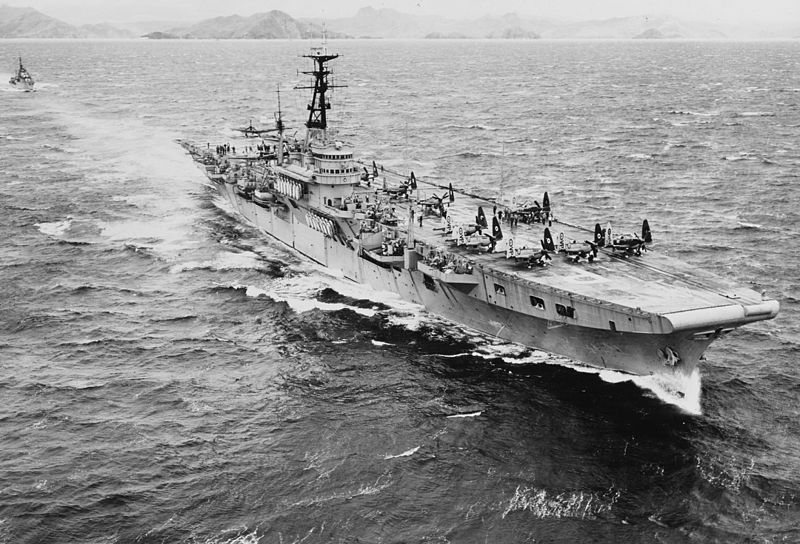
HMS Triumph in 1950
design development
The 1942 Design Light Fleet Carrier had for first challenge to be built by civilian shipyards, as regular military ones were already busy with completing ships on order and repair others. In fact the combat intensisity was such as west coast US shipyards also took part in this enterprise. The admiralty knew the fleet could not afford in wartime to built more armoured fleet carriers, and needed rather numbers, looking for a cheaper, smaller, intermediate step between fleet aircraft carriers escort carriers. They were to be faster than the latter, carrying almost double air group, and could be used for a larger variety of missions.
On the deck of those in charge of the design were dozens of combat reports of experiences in the early part of the war, inclusing limited expoerience with escort carriers, which were few in numbers at the time, starting with HMS Audacity. At least these shown the need for defensive air cover for convoys wether in the Atlantic or Mediterranean. Their conclusion, the same as the USN for the Pacific theater later, was just more aircraft carriers.
By mid-1941 already the Director of Naval Construction (DNC) was ordered to look out how to shorten the normal process of a lengthy construction for a carrier, with options such as:
-Converting the two Hawkins-class heavy cruisers (Hawkins and Forbisher), old but fast and large, with flight decks and aviation facilities.
-Convert large merchant vessels and better, passenger liners available into better versions of the merchant aircraft carriers (MAC)
-Create a brand new, simple and cheap design of lightly armed and unarmoured carriers, (such as Woolworth carriers)*.
In December 1941 after much arguing, the latter option was chosen, but a step further than escort carriers.
*Name given on the RN for commercial hull-based escorts, called in the US “jeep carrier” or “baby flattop”.
It was argued that The design had to be as simple as possible so construction time was reduced and include more shipyards into the construction scheme, and this including vivilian ones, those without naval construction experience. And still, the admirakty wanted these ships sophisticated enough to take part in fleet actions, not just escort. That implied a greater speed and greater air grooup, better faclities than fleet escorts. Quite a daunting prospect for engineers. The project was first dubbed ‘Intermediate Aircraft Carrier’, and as it evolved, ‘Light Fleet Carriers’ but since the naval design staff was completely underwater, the best available desig bureau next in Great Britain for this task was at the shipbuilding office of Vickers-Armstrong.
So these carriers could also be called the “Vickers Carriers” as they were indeed their design in very large part.
Another aspect was that Vickers and the admiralty intended these as “disposable warships”, to be scrapped after the war. But as a testimony to the soundness of their design and construction, they largely exceeded all expectation, having enough modularity for many upgrades and reconstructions, and seeing most of the cold war under other flags, the last being retired in 2001.
Construction
Construction was eventually approved by the Naval Board in February 1942, as soon as the Vickers design was overviewed. The first batch of orders comprised HMS Colossus and Glory laid down in March.
In total, no less than sixteen were planned, and so fourteen more of now “Colossus class” were laid down and assigned to eight shipyards: The lead ship, naturally was laid down at Vickers-Armstrong on 1st June (and later HMS Pioneer and Perseus), followed by renowned large civilian yards also with in some case, warship construction experience: Harland & Wolff (Glory and Warrior) or Titanic fame, Stephen & Sons (HMS Ocean), and by those also more accustomed to military ships: Cammell Laird (Venerable) and Swan Hunter (Vengeance), Fairfield (Theseus) and Hawthorne Leslie (Triumph), until then more accustomed to destroyers.
For the next sub-class Majestic, the same but HM Dockyard Devonport were added to this list. All in all, the two more “prolific builders” were Irish Harland & Wolff and London’s Vickers-Armstrong which also built the most carriers (5)n with the exception of HMS Hercules started there but fitted out at Harland & Wolff.
Originally the admiralty planned a “keel laying to commission” time of 21 months, but many modifications in design had these plans shattered and the standard duration went to 27 months, two years and more which meant they were certainly too late for the show for most. Builders even omitted many of the intended equipments, notably those for backup, but just two ships were built on 27 months.
Those launched from late 1943 were all commissioned in 1945 (with a single exception in December 1944) and thus in the end only four were ready on time to be massed into a single coherent fleet unit called the 11th Aircraft Carrier Squadron: Colossus, Glory, Venerable, and Vengeance. Only eight out of sixteen were completed on the original design. All the other were modified by taking in account war lessopns, starting with the Majetic class, of which none saw wartime service. The design was heavily criticized though, beyond poor living conditions until hammocks were banned for fixed bunks like the USN and centralised eating arrangements.
Design
Hull construction & protection

Arromanches/Colossus hull design, docking drawings
The Light Fleet design was completed quickly, in February 1942, and Vickers engineers just took the Illustrious and scaled it down as a base for work. The rest was mostly simplifications left and right. The final displacement was setup at 13,190 tons standard for 18,040 tons fully loaded and the total lenght stretched to 680 feet (210 m) at flight deck level but 695 feet (212 m) overall at the poop, and 80 feet (24 m) in beam, just enough for plances to be stored, wings extended in the hangar, or some having room to take off with some stored on the side of the deck. The ship also had a projected draught of 18 feet 6 inches (5.64 m) standard displacement and up to 23 feet 6 inches (7.16 m) fully loaded. The interesing part was that the hull was built to Lloyd’s specifications for merchant vessels with however better compartment subdivision under the waterline. As planned, there was no armour nor specific areas of protection.
In overall appearance, these carriers indeed looked like reduced Illustrious carriers. The most disctintive traits common to these classes were the forward flared flight deck/bow connection or “hurricane bow” (something ported later on their Essex class under construction after painful experience with typhoons), and a smaller island, but still structured the same way with a three-stage bridge, tripod mast supporting the main fire director and radars, and a single, main straight funnel.

Arromanches/Colossus hull design, exterior fittings
Propulsion
The propulsion machinery was however to cruiser standards, those of the Fiji-class cruisers, with four 10,000 shp Parsons steam turbines coming from additional cancelled cruisers. These turbines would be placed into two single compartments, each fed by two Admiralty 3-drum boilers. The two turbines however were staggered en echelon, the starboard compartment being forward of the port ones, combined onto a single shaft. In total, they were rated for 40,000 shaft horsepower, enough for 25 knots (46 km/h; 29 mph) and 15 knots while cruising. This was indeed less than large fleet carriers, but far better than escort ones so that they could take part in fleet actions if needed. This also proved a rugged and dependable machinery, as testified by their long service life.
Armament
HMS Colossus, Glory, Venerable, Vengeance had the original armament of six quad 2pdr (40mm/39) QF Mk VIII, but also eleven twin and ten simple 20mm/70 Oerlikon Mk II/IV and a permanent hangar park of 37 aircraft. HMS Theseus and Warrior were however completed with less “pompoms” and more Bofors: Nineteen single 40mm/60 Mk III Bofors and six quad 40mm/39 Mk VII, no Oerlikon. Their hangar park was also of 37 aircraft, with the latter types (see below).
HMS Triumph was uniquely armed with twelve single Bofors 40mm/60 Mk III, and six quad 40mm/39 QF Mk VII pompom but received soon three single additional Mk VIII. (same air park)
HMS Ocean had six quad pompom Mk VIII plus seven single, and ten twin 20mm/70 Oerlikon Mk II/IV and a permanent park of 32 aircraft.
2-pdr QF pompom Mk.VII/VIII
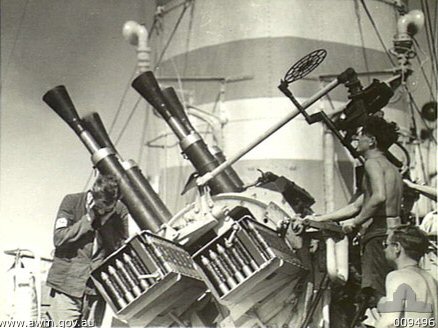
The original six quad pompom were located on deck sponsons, four abaft the two axial lifts, one in front of the island, one aft of the funnel, on the island’s roof. The Mk.VIII was an old piece of kit already but more effective when combined with the MK IV Director and Gyro Rate Unit plus the Type 282 radar. War lessons, notably with HMS Illustrious′s Mk VIII (HV) mountings was very effective but still some recoignised that the performances of the few Bofors on HMS Prince of Wales when air attacked near near Singapore with their tracers were more effective than a multiple pom-pom in director control: The pom-poms lacked tracer ammunition, and the latter deteriorated in ready use lockers whereas the Type 282 radar failed in the equatorial heat.
In the end, the Royal Navy judged the pom-pom’s effectiveness as half the Bofors per gun in range, and same level against both torpedo planes and Kamikaze. Thanks to its octuple mounts it still outnumbered the Bofors in Commonwealth ships and served upt to 1945.
By 1944, both Remote Power Control (RPC) and radar tachymetric direction increased accuracy while issues with fuses and reliability were solved. In fact the single mount Mk.VII started to replace the 20 mm Oerlikon on a one-to-one basis since the latter had insufficient stopping power, and also to alleviate the lack of Bofors guns supplied.
20mm/70 Oerlikon Mk.II/IV
The Oerlikon guns were located in four groups of three, two sponsons forward and two aft, plus individual sponsons along the decks. It was clear by the summer of 1945 that this caliber was too weak to be of service against the latest generation of IJN aircraft and especially Kamikaze. They were replaced gradually at a one-per-one basis by single Bofors Mk.III on the four WW2 service carriers, and omitted completely on the Theseus, Warrior, and Triumph. The fact they were also on HMS Ocean has more to do with surplus.
40mm/60 Mk.III M Bofors
They were fitted on the late completed vessels, between single and quad mounts, knowing the latter replaced QF 2-pdr Pompom on a one-per-one basis, so on the same locations, and the single ones in place of the 20mm Oerlikon. This became the standard during transfers post-war in 1946-47. The USN in the summer of 1945 also reached the same conclusion and starte to remove the 20 mm Oerlikons and replaced them by single Bofors mounts when possible.
Aircraft Facilities
These ships were given the same flight deck design as for the Illustrious and Indefatigable classes, but smaller, measuring 210.3 m x 24.4m (390 x 80 feets) representing a surface area of 5,131m² (55,229.62 square feet). It was caraterized by two axial lifts, both rectlangular and the same size at 13.7 x 10.4m (45 x 34 feets) and weighting 6.8t (13.600 Ibs). They were located at equal distances from the prow and stern, the first used to launch aircraft as it was immediately close to the catapult.
There was a single catapult BH-III forward to the left side, capable of launching a 6.4t (12,800 Ibs) aircraft at 122km/h (75 mph).
There were ten arrestor cables, starting from the stern landing deck’s edge to about 2/5 of the deck, one crossing the aft lift. There was no crash barrier.
HMS Triumph would be the first in 1952 to test an angled flight deck, an idea from Navy Captain David Campbell.
The hangar measured 135.6 m (445 ft) overall in lenght, 15.8 m (52 ft) in width, and 5.3 m (13.4 ft) in height. This represented a total area of 2,142m² (23,000 sq.ft) and a total volume of 11,355m³ (400,000 Cubic Ft). As a reminder, 15.8 was larger the span of the Barracuda, wings unfolded. Since they all had wings folded, this was enough to store two aircraft side by side.
Aircraft fuel stowage carried onboard was 448,200 liters. They were located deep inside the hull, with backup safety for the pumping system up to the hangar there they were refuelled. The storage was judged adequate, but during their service in the pacific, autonomy left to be desired, and they needed more resplenishments, reducing their avialability. Resplenishment at sea was made mandatory for the next Majestic class, includung if possible aviation gasoline capacity was reduced further.
Air Group
Originally, all four carriers in service with the BPF (HMS Colossus, Glory, Venerable, Vengeance) had a permanent hangar park of 37 models, with fighters such as the Supermarine Seafire and FB like the Fairey Firefly, but certainly not the Wildcat IV (planned, still, in 1942), rarely the Hellcat (see below), but certainly the Corsair, standard with the BPF. It seems they were planned to carry the Swordfish also in early 1942, but it was replaced when commissioned by the Fairey Barracuda, and not the Avenger despite some sources saying so. Blackburn Firebrand: It seems only HMS Implacable and later HMS Indomitable used this model postwar, and they saw little service, as well as the HMS Eagle until it disbanded on 19 November 1952. No reference or photo about any use exists or is mentioned to my knowledge on the Colossus/Majestic class. The seafire and firebrand were apparently only used until their transfer to the Pacific, and back from it.
Supermarine Seafire
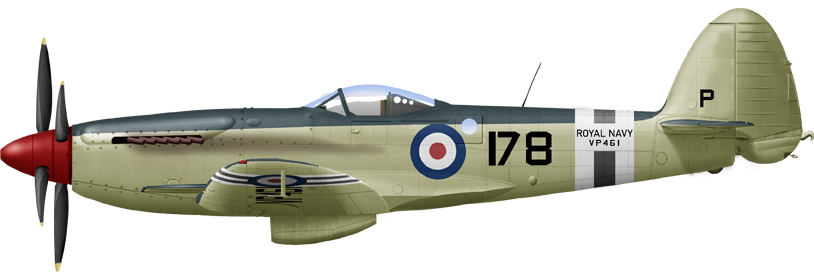
Supermarine Seafire Mk.47, VP480, N°800 NAS, 13th Carrier air group, HMS Triumph, North Korea July 1950. This was the only wartime action of this type for this class. These models carried “invasion bands” below and above the wings and aft of the fuselage.
The Mark 47 was probably the ultimate variant of a history-making classic, derived for naval use from the Spitfire. Among others it has a five-bladed propeller and a top speed in excess of 441 mph (710 km/h, 383 kn) and with the FS supercharger gear could climb at 29,500 ft. But the seafire Mk.I to Mk.III really had serious issues for carrier service: Converting a short-range land-based interceptor was not easy and compromises led to many structural damage due to heavy landings, while indeed at sea its short range condemned it to CAP (Carrier Air Patrol) work only. These problems were mostly cured by the time the Mk.14 arrived, more so on the “ultimate” Mk.47, which prodcution was slow and limited, and it only arrived in service from January 1948, seeing action on only a few light fleet carriers in Korea.
Fairey Firefly

Author’s illustration of the Firefly FR. Mk.I of the 837 Sqadron, HMS Glory, BPF 1945
A well-documented use. The Firefly also served in the RNAAF, notably as late as in Korea. The replacement for the triple cap Fairey Fulmar. It was a long range fighter/reconnaissance/ASW patrol aircraft which could double as attack aircraft with 4 × 20 mm (0.787 in) Hispano Mk.V wings cannons, 16x RP-3 60 lb (27.2 kg) rockets and up to two 1,000 lb (454 kg) bombs. Introduced from March 1943, about at the same time as the Barracuda, it was fast and powerful, way superior to the Fulmar. Proving very sturdy, long-ranged and docile it was declined into nine main variants and over 1700 were built, seeing also action in the cold war and with seven other countries aside the Commonwealth.
See also 1
Fairey Barracuda
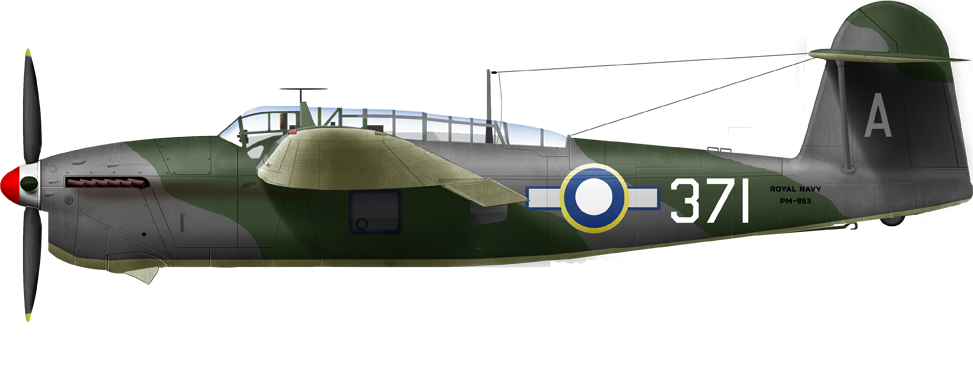
Author’s illustration of a Barracuda Mk.II from 812 NAS, HMS Vengeance, BPF, 1945
The replacement for the Fairey Albacore, itself replacing the venerable Swordfish. This unusual high-wing monoplane was fitted with a set of large Fairey-Youngman flaps doubling as dive brakes to perform both the roles of torpedo carrier and dive bomber to replace the obsolete Skua. Underpowered at first, the main production versions swapped on the RR 1,640 hp (1,220 kW) Merlin 32, which was good all around but had no supercharger for high altitude missions.
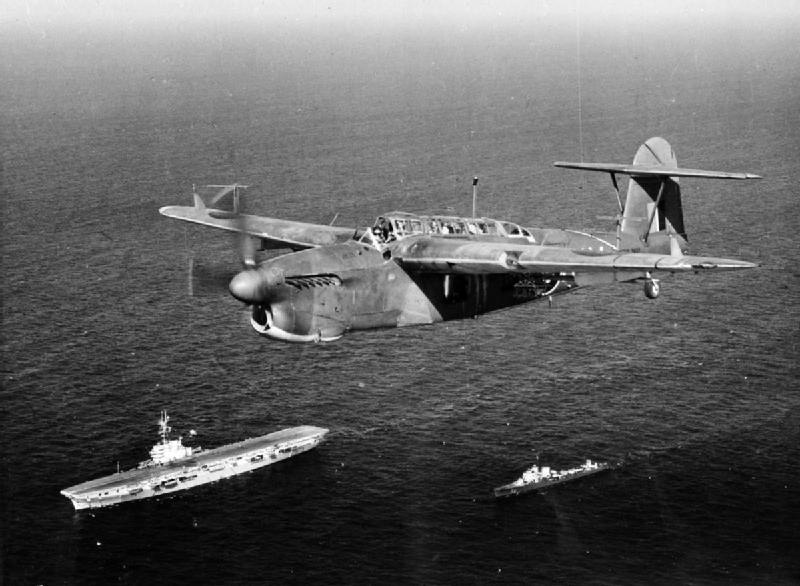
Fairey Barracuda Mk.II, 814 Naval Air Squadron
Deployed from early 1943 on FAA Carriers, it took part notably in Operation Mascot and Operation Goodwood agains Tirpitz, but was also deployed with the British Pacific Fleet at the end of the war, not replaced by the Firefly which was a long range fighter/attack aircraft. It should have been replaced by the Blackburn Firebrand. They formed the backbone of the 11th ACS from June 1945, each with onboard the same single Barracuda and single Corsair squadrons. They were proferred over the Avenger which mostly served with armoured carriers.
Hellcat Mk.II (1944)

Seems there are contradictory information here. The only fleet carriers using these were HMS Indomitable and the only Colossus class was HMS Venerable (photos). No side photo to make a profile though. If you know one, thanks to point it out ! Other sources states HMS Ocean carried them but i can’t confirm this in my sources nor i could not found photos. Ex.
Corsair Mk.II (1944)

Author’s profile of a Corsair Mark II (F4U-1D) onboard HMS Colossus in February 1945
Deployed on all four British Pacific Fleet Carriers from February 1945. Here is one from HMS Colossus at that date. It was the standard fighter-bomber for light fleet carriers of the BPF mostly for standardization, as it was fully integrated with the US TF 38/58 and referred accordingly as Task Force 37/57. The BPF was formed in November 1944 but the light fleet carriers really started frontline operation by June 1945. The British FAA was an early adopter of the Corsair for carrier operations, starting in November 1943 with 95 Vought F4U-1. They soon found a way to its landing visbility issue, with a visual display system later adopted by the USN as until then it was relegated to land-based USMC operations in the Pacific.
By the time the 11th Aircraft Carrier Squadron was constituted in the Pacific they had received two squadrons only, one of Corsair Mk.IV (Goodyear FG-1A and FG-1D) introduced in early 1943 and replaced later from mid-1944 by the Corsair Mk.II (F4U-1D), of which 150 were delivered. With 21-24 (2 each) on each carrier, the 11th ACS had 51 of this total affected. They acted as fighter bombers from June 1944 and there was a lot of emulation and co-training with USN Corsair pilots during the last summer mission over Japan related to combined tactics.
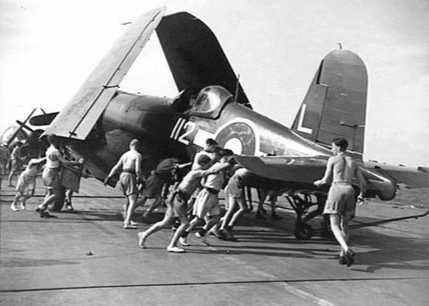
Corsair II on HMS Glory off Rabaul, 1945
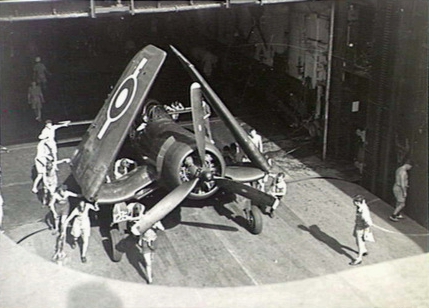
Corsair II being pushed on elevator, HMS Glory, 1945
On HMS Glory in August 1945, at the war’s end, had 21 Corsair and 18 Barracuda on board. This was quite representative of the end of the war for BPF carriers. After the war, cost-cutting obliged, air groups dwindled down.
Hawker Sea Fury
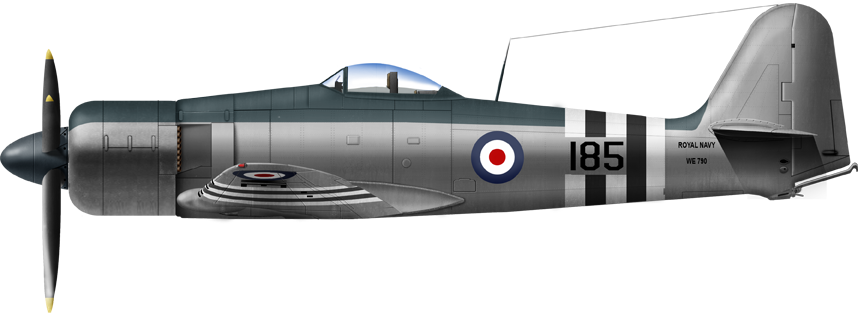
Author’s illustration of the Sea Fury
Post-war use only. A development of the land-based Hawker Tempest, adapted for naval use, the Sea Fury really was the last piston-engine model to enter service with the RN, boasting even with the full additional ordinance, a top speed of 460 mph and 20,000 feet climbed in just under five minutes, while staying very agile. It was almost overpowered with a 3,000 hp (2,200 kW) Bristol Centaurus engine coupled to a five-bladed propeller. If the Tempest was rugged, the Sea Fury was even sturdier, but also more compact and lighter. It was comparable in a sense to the Grumman Bearcat. From 1948, the Sea Fury entered service on nearly all light fleet carriers completed and those not yet leased or transferred, and saw plenty of action in Korea. A superb machine, production only stopped in 1955 and it served until 1968 in the Malay air Force among others.

Sea Fury taking off from HMS Ocean (R68) at Sasebo, 1952
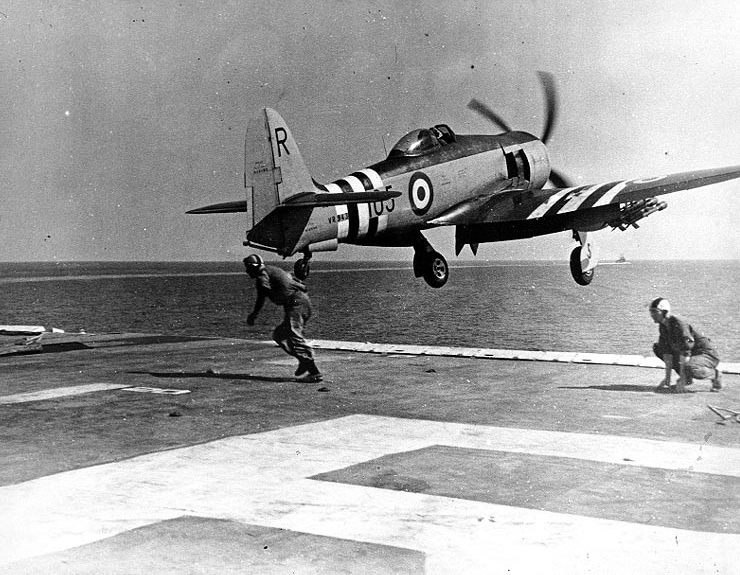
Hawker Sea Fury F.B.11 during the Suez crisis, 1954
De Havilland Sea Hornet

Post-war use only. The Sea Mosquito was a first step into the reconnaissance/attack role in the fleet air arm already, and it was toughout a dedicated long range fighter based on the same basic features, including a new wood glue, Redux, and alcad, insertion of aluminium as reinforcements. Apart from the structure modernized, the wings represented a sythesis of the aerodynamic knowledge accumulated since the Mosquito with a laminar flow. The Sea Hornet entered in service too late for WW2, in 1946 and was indeed deployed on post war light carriers, used notably during the malay insurrection (1948-60) with success. With only 383 built, it was retired in 1956 from the frontline.
In 1950, HMS Vengeance carried 12 Firefly Mk.5, 8 Sea Hornet NF.21 and Triumph the same but 12 Supermarine Seafire F.47 instead of the Sea Hornets, while in action in Korea. Two years later, HMS Ocean carried 22 Sea Fury FB.11 and 12 Firefly AS.5 and three years later, she was reconverted as an helicopter carrier, carrying 6 Whirlwind HAR.1 and 6 Sycamore HAR.1, while HMS Theseus had ten Whirlwind HAR.1 on board.

De Havilland Vampire tested aboard HMS Ocean, Dec. 1945. The carriers completed with postwar modifications were used for many tests, includind those of early jets, such as the De Havilland Vampire here, as a 1st gen naval jet fighter.
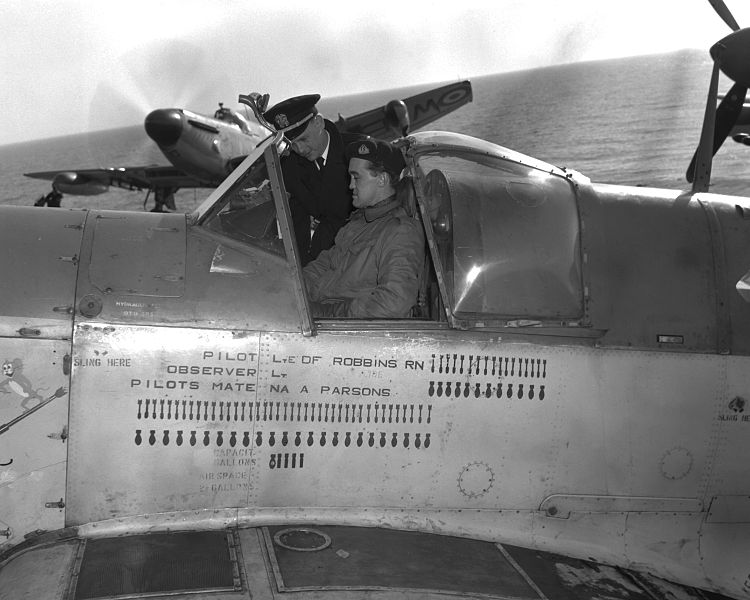
Fairey Firefly over HMS Glory, Korea 1953
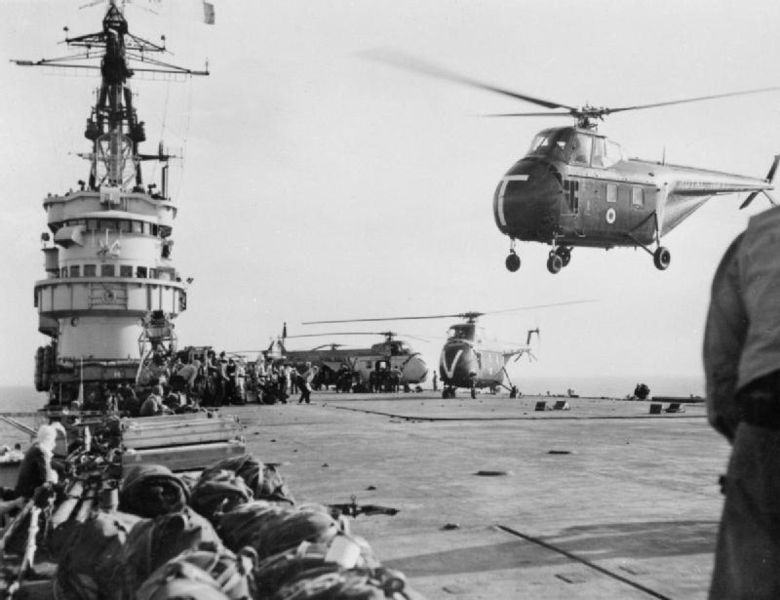
Westland Whirlwinds taking off from HMS Theseus (R64) at Suez, 1956
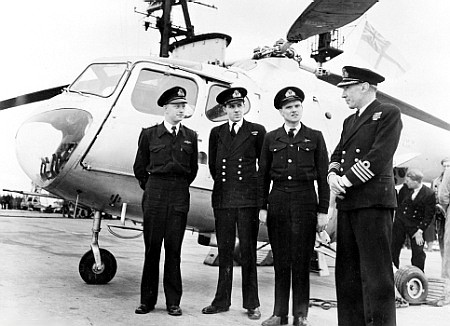
Bristol Sycamore and officers on HMS Vengeance
Electronics
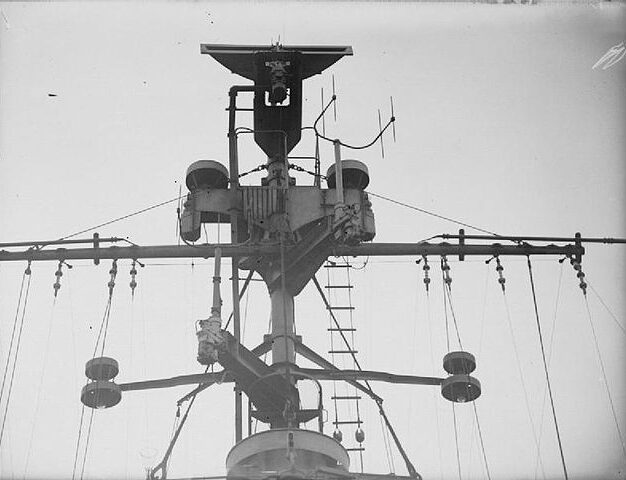
Type-293 AUR antenna upper center aboard HMS Swiftsure, Scapa Flow
At the end of their career, they allegedly carried a Type 79B, a type 281B radars and six type 282 fire control radars and the type 144 sonar
HMS Ocean: One SM-1 radar, six type 282, type 293 radars, type 144 sonar
Type 293 Air/Surface Search Radar: Designed as a short-range aerial-search radar in 1945, used the same transmitted as the Type 277 but new antenna design to also provide air warning. It had a stabilised “cheese” antenna 6 feet (1.8 m) in diameter, later 8 feet (2.4 m) and 12 feet postwar as the Type 293Q.
Type 291 Air Warning Radar: Designed as a destroyer type ship search radar in 1942 it became widespread on any slight ship. It worked at 214 MHz with a PRF of 500 per second, Beamwidth of 40°, Pulsewidth of 1.1 μs, Range of 9 nmi (17 km; 10 mi) and working on a 100 kW power.
Type 277 Height Finder Radar: The Type 277 was a surface search/secondary aircraft early warning radar developed from the Type 271 radar with more power and better signal processing as well as new displays and new antennas. It started to replace the type 271 in 1943 the largest ships, down to the destroyer.
Modifications
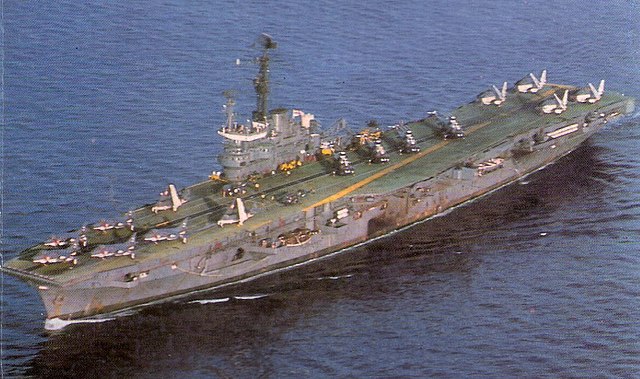 INS Vikrant (ex-Hercules) in the 1980s. She has going through many modifications from 1946 and was decomm. in 2014, the oldest of all of these carriers.
INS Vikrant (ex-Hercules) in the 1980s. She has going through many modifications from 1946 and was decomm. in 2014, the oldest of all of these carriers.
The ships were barely in service in WW2 and already changes were made in AA artillery and radars as well as air group. But it’s for the completed ships postwar that the greatest changes occured.
In the 1950s it was clear that classic straight flight decks were not an optimal solution to manage air operations aboard, with always dangerous landings where there was a possibility of a crewh into the ones disposed for take off. This led to the idea of side lifts (which was dropped due to too much complications), but also of angled decks.
Angled Decks

Animation of a simple 6° angle deck on HMS centaur. Not much modifications needed in that case. On US carriers when air group operations were larger (meaning two taking off from the bow, not one like here), the angled deck had to be much more offset to port. An obligation since the island, obviously was always located to starboard. Modified SBC-27 Essex had two forward catapults and a much more angled deck, to 8-9°.
British angled decks development goes to RN Captain (later Rear Admiral) Dennis Cambell, working on a design study started in the winter of 1944–1945 after seeing so many frustrating deck operations and accidents. His report carried enough weight to be reviewed by a committee of senior Royal Navy officers, which decided that the future, with jets which obviously needed more deck space due to their higher landing speeds urged this modification to be ported on all existing carriers and those in construction.
Also called the “skewed deck”, “canted deck”, “waist angle deck”, or simply the “angle”, this was not just limited to a mere repainting of the deck. The aft part of the deck was widened, a separate runway was positioned at an angle from the centreline, ending with a specially built hull sponson-type extension (replacing existing sponsons by the way), reorientation of the arrestor wires, and new crash barrier, further forward. At least if the jet missed, it had some extra margin to take off again or ditch at sea but at least not collide with planes waiting for takeoff forward. This was a crucial evolution since the invention of the catapult to segment flight operations and a necessary adaptation since the biplane era of the interwar or landing speeds were much lower.
Calculations of landing speeds for the new jets in development, such as the De Havilland Vampire (which first flew in 20 September 1943, and it’s naval variant, the Sea Vampire, in 1944) and designs by 1945 of an angled flight deck commence in the idea of almost taking the entire lenght of the flight deck. The main advantage, since the forward lift was directly behind the starboard catapult, to streamline air operations, having simultaneous launch and recoveries, and abort landings, saving lives and materials.
This angled deck also displaced further portside the landing area and thus freed some margin for engineers to mount of a larger island, for improving ship-handlingn flight control, mount larger antenna and radar arrays, etc. This also still left a large open area amidships for arming and fueling parked planes and do some damage control. All in all, despite the limitation of small carriers like the Colossus and 1942 programme light fleet carriers in general, it became the staple of STOBAR and CATOBAR cold war developments. It was all experimented on the Colossus class vessels:
To be more prescise, it had to wait until 1952, when HMS Triumph was mofified at first with simply painting angled deck markings onto the centerline for touch-and-go landings, and on the other side of the pond on USS Midway. But by September to December 1952, USS Antietam obtaine a new sponson installed for a true angled-deck, making full arrested landings trias proving that solution was superior. In 1953, USS Antietam had British naval units training on it, and HMS Centaur became the first modified with a proper overhanging angled flight deck in 1954. In February 1955, HMS Ark Royal became the first fleet carrier to be constructed with an integrated angled deck. It was retrofitted for many other ships of the Majestic class such as HMAS Melbourne.
Reinforce Decks, larger catapults, lifts, etc.
Operating jets forced upon engineers a rethinking of the whole structure as well. The first goal in 1946 when were started to be completed the modified Majestic class was to accomodate 15 to 18,000 Ibs aicraft, but by 1955 the new standard was 20,000 Ibs+. Unlike wood and canvas structures of the 1920s with a small radial engine, jets were “full like an egg” between the turbojet and electronics, in addition of being all-metal. These models imposed by definition a much heavier deck.
It should be noted that rubberized decks were tested at some point

HMS Colossus in 1945, old author’s illustration. It was the typical camouflage of the day, with some alterations from one ship to another: Central dark navy blue band typical of allied camouflage in 1945 for large vessels, and wavy medium blue-grey bands on either sides.
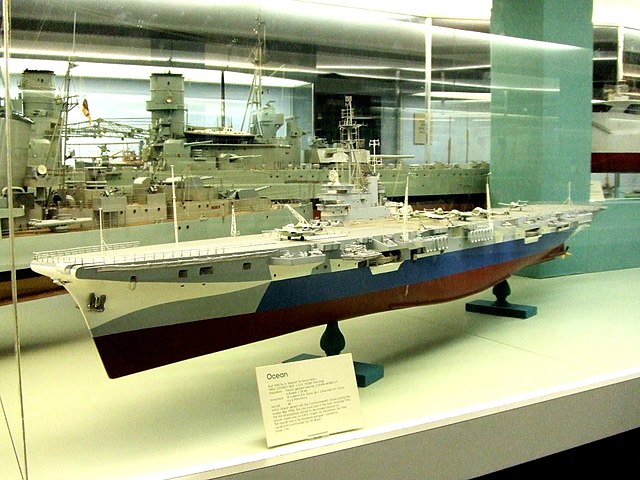
A model of HMS Ocean in 1945, showing it’s own camouflage

HMS Perseus in 1950

HMS Triumph as a test ship in 1979
HMS Colossus (1944) |
|
| Dimensions | 695 ft oa x 80 ft x 18 ft 6 in st./ 23 ft 3 in FL (211,3 x 24,8 x 7,1 m) |
| Displacement | 13 500 t. standard, 18-19,000 t. Fully loaded |
| Propulsion | 2 shaft Parsons geared turbines, 4 Admiralty boilers 40 000 hp (30.000 KW). |
| Speed | top speed 25 knots (46 km/h; 29 mph) |
| Range | 12,000 nm (22,000 km)/14 knots (26 kph or 16 mph) |
| Armor | Belt, decks max 190 mm |
| Armament | 6×4 2pdr pompom AA, 16x 20 mm Oerlikon AA* |
| Air Group | 37-52 aircraft (1945) |
| Crew | 1,050 to 1,300 wartime with air group personal |
Wartime service: 11th Aircraft Carrier Squadron
Following the retirement of the RN from the Indian Ocean in 1942, no operation could be mounted in the South West Pacific theatre until at least 17 May 1944. This time, with transfers and completion with US ships Operation Transom was launched on Surabaya. However since the US were in effect liberating British territories it was seen as an extension of their influence, urgeing as a political and military imperative to restore a British presence and take part in the pacific campaign, but also to retake Hong Kong and Singapore using British forces alone. However Churchill argued against it, as he did want to be only a junior partner, or that effort should be concentrated on Burma and Malaya. Naval planners, supported still supported the naval staff in what it was essential to restore British influence.
After transom, the British proposed a limited British role in the Pacific, but Admiral Ernest King was reluctant to this prospect, until the future Fleet send there should be self-sufficient, not depending on US resplenishment and supply netwwork. However during a meeting President Franklin D. Roosevelt overruled Admiral King’s opinion on that matter. The Australian Government was a good example of integrated combined operation with the US counterparts, having a common strategy and also wanted the British to counterbalance US omnipresence there.
The British Pacific Fleet or BPF was constituted around Admiral Sir Bruce Fraser at Trincomalee. It was called at first the “British Eastern Fleet” but his flagship was… the gunboat Tarantula. Later he would move his flag to the more suitable battleship HMS Howe.
The new Eastern Fleet was based in Ceylon and merged into the British East Indies Fleet to create the British Pacific Fleet, starting operations with limited means on Sumatra and later moved to Sydney.
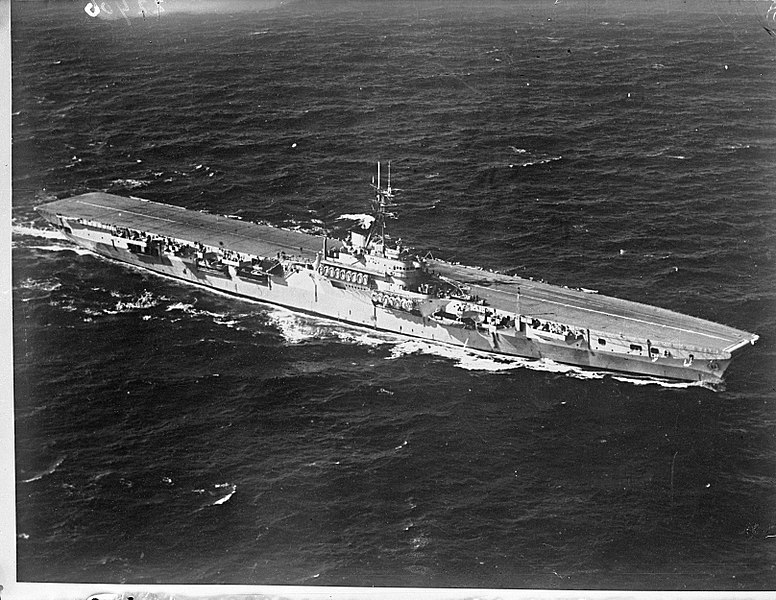
HMS Venerable in 1946
The Royal Navy mobilized capital ships, aicraft carriers, cruisers and destroyers plus the Royal Fleet Auxiliary (RFA), and tried to aggregate the Royal Australian Navy (RAN), Royal Canadian Navy (RCN) and Royal New Zealand Navy (RNZN) elements, now that the Atlantic campaign was ending. It happened that on aircraft carriers in particular, many naval aviators were New Zealanders and Canadians. Personal from the South African Navy (SAN) was also aggregated, and a complement of ships by the USN, operating from facilities in Australia and New Zealand and soon a new CiC, Admiral Sir Bruce Fraser, with tactical command delegated to Vice-Admiral Sir Bernard Rawlings, whereas Vice-Admiral Sir Philip Vian was in charge of FAA operations. For a better integration with the USN, it was referred to as Task Force 37 or 57 (depending on the command), mirroring the US TF 38/58. The indispensible Fleet Train was called Task Force 113, with all FAA groups aggregated into the 1st Aircraft Carrier Squadron, based on four armoured aicraft carriers.
However the self-sufficient requirement was difficult to comply with, since the constitution of a fleet supporting a naval force at sea for weeks or months lacked proper infrastructures in the Pacific. However many officers did not agreed with King’s decisions and USN logistics authorities interpreted self-sufficiency in a “very liberal sense.” foortunately for the PBF. The fleet train at first indeed was only constituted with 20 vessels, whereas 134 merchant ships (1½ million gross tons) were expected, so the remainder was to make due between British merchant ships out of a pool of 560, already strained, and US vessels. Everything was being setup in February 1944, but it’s only by December that the BPF was ready to take part in major Pacific Operations.
A forward base was established at Seeadler Harbor in Manus atoll (Admiralty Islands) since Sydney was too far away and the FAA established Mobile Naval Air Bases (MONABs) in Australia mostly for supply and technical support, starting operations in January 1945.
The first major operation was Operation Meridian, air strikes in January 1945 against oil production at Palembang, Sumatra. The BPF now renamed Task Force 57 was named so when joining Spruance’s 5th Fleet on 15 March 1945, and TF-37 for Admiral William Halsey’s 3rd fleet. Its first combined operation was for Okinawa: The BPF supported the invasion by operating against the Sakishima Islands in full autonomy. However, when it arrived in Sydney by June-July, ofter after a stop at Manus (admiralties), the 11th ACS had little operations to do. The war ended in August and in the end they really never took part in frontline operations against the Japanese Home Island. This was just too late. Instead, they were often spread up for the British to retake Shanghai, Hong Kong and Singapore among others, as planned. They provided cover during troop landings and re-occupation, rounding up Japanese prisoners, locating and dealing with those still waging guerillas, accepting official surrenders of local officers, and when back home, providing much needed repatriation notably for POWs. For some, like the modified HMS Pioneer, they also provided reconstruction services, restablishing infrastructure.
Therefore, they never really “fought” in WW2, being either working up, fixing issues, qualifying pilots and training underway, despire being commissioned in late 1944 or early to mid-1945. Four month was the bare minimum to be operational.
When they were deployed, they carrier the following, standardized air groups:
Colossus: 24 Corsairs, 18 Barracudas
Glory: 21 Corsairs, 18 Barracudas
Venerable: 21 Corsairs, 18 Barracudas
Vengeance: 24 Corsairs, 18 Barracudas
Essentially, having no armour, meant these carriers needed to be kept away from known attack area of Kamikazes, in a second line. They could not really take on the same tasks as the armoured fleet carriers of the BPF, but provide them only distant support, scrambling air patrols on demand and operate in relatively uncontested areas against ground targets. In this, the Corsairs provided the means of attacks and fighter protection, while the Barracdua (which was disliked by pilots as underpowered and plagued by poor flight controls, they were confined to the 11th ACS, whereas replaced by Avengers on the active armoured fleet carriers of the BPF, with relief.
Having practically no use so close to the end of the war, these “disposable emergency carriers” could have been simultaneously one of the greatest waste of money of British taxpayer’s money ever, but in reality if some were indeed placed in reserve, they almost all served in Korea. Those not sold were scrapped in the late 1950s (Pioneer was a bit of an exception, BU in 1954) and early 1960s, some were transformed as floating workshops, many postwar new techniques and transformations were tested on these ships, having an influence on post-war completion of new aicraft carriers: Reconstruction of Victorious, modified sub-class Centaur comp. 1953-54, HMS Eagle (ex-Audacious), HMS Ark Royal -started 1942-, and HMS Hermes -started 1944- the last “classic British fleet carriers” before the STOBAR 1980s Invincible and 2010s Queen Elisabeth class.
But half were also sold: Colossus, Venerable, Vengeance, Warrior, Magnificient, Terrible, Powerful, Majestic, Hercules, being modernized sometimes twice or thrice, before and after transfer, seeing service for some with three navies (RN, Netherlands, Brazil for example), and being that cheap to acquire (based notably on their civilian construction), giving these countries an unexpected entry into the “great navies privilege”, the new capital ship that really counts. Some navies got rid of them over time, not based on limitations but simply on budget reaffectations, especially Australia, Canada and the Netherlands. It should not be forgotten that these vessels are costly to operate and maintain due due to their large size, consumption and crew. And they lacked proper armament anyway (they just had some room for 40mm Bofors, which were pretty useless against modern jets of the 1970-80s), could not operate good, large modern fighters (the A4 Skyhawk of the Argentines and Australians for exemple were no match for soviet-block interceptors such as the Mig-21 and beyond), or, like the Indians, only VTOL aircraft such as the Harrier. The lack of adequate ASW escort also condemned ARA Ventincinco de Mayo to be stuck in port for safety during the Falkland war due to the danger of British SSNs.
A remarkable post war career
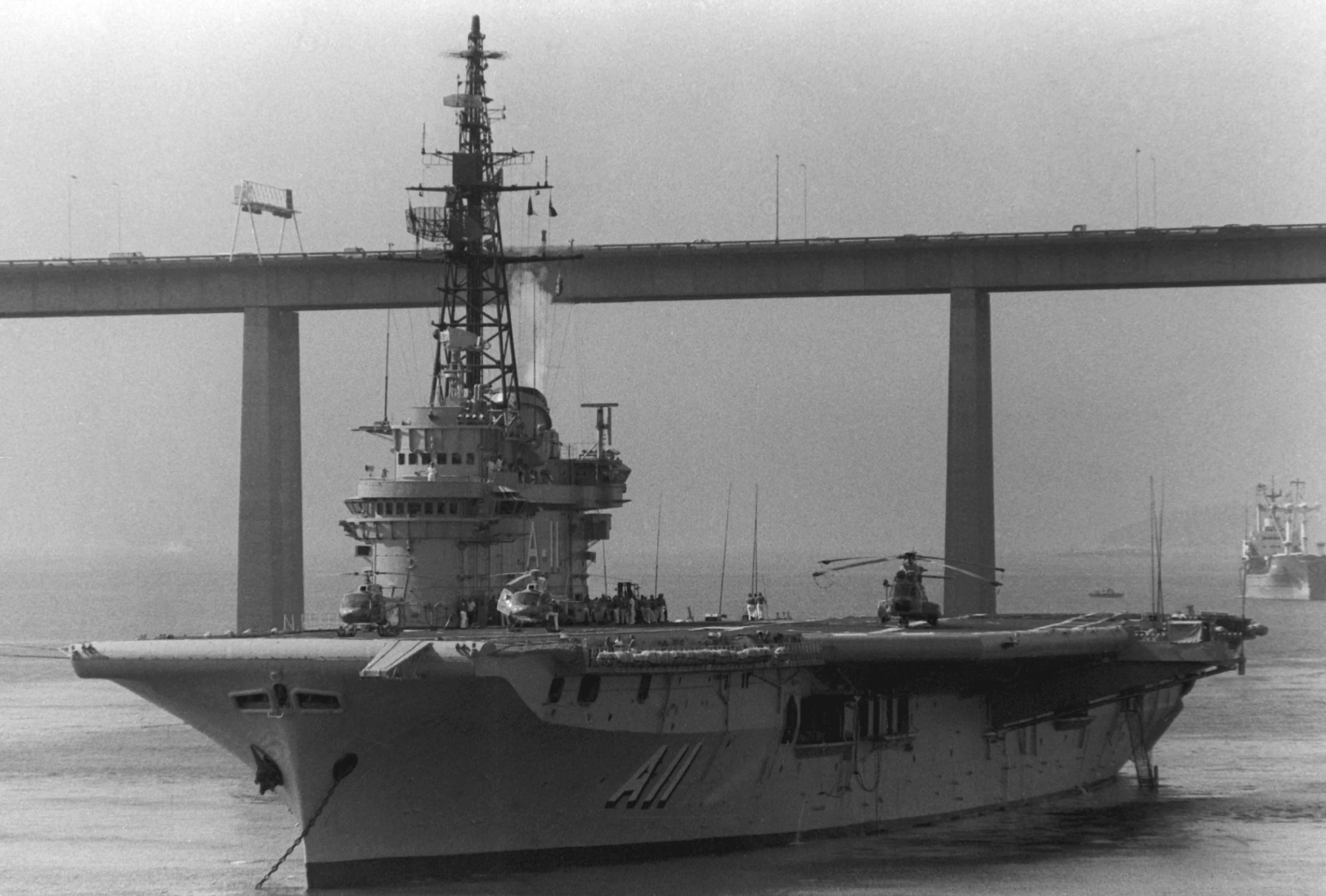 NRB Minas Gerais
NRB Minas Gerais
The whole class, especially the Majestics, saw action much more in the Korean war, than in WW2, making mpultiple tours of duty and taking part in the first air attack against Korea. HMS Ocean was deployed twice and Glory thrice, Theseus even ten times. They especially deployed the Sea Fury, pinnacle of the British piston-engine fighter, and an equally good fighter and bomber, which was the first to manage to shot down a Mig-15 in 1952. A rare case of piston-powered fighter preying on its jet analogue, symbolic of this transitional era. HMAS Sydney, former HMS Terrible, also operated in Korea and carrying out 2,366 sorties, with ten aircraft lost, usually to AA. Sydney would also have also later a tour of duty in Vietnam, as a troop carrier.
The French Navy loaned the lead ship, HMS Colossus, which was later purchased and renamed Arromanches, to serve in the Indochina war, seafires making 152 sorties, but with many accidents, and later she made three other deployments this time with Grumman Bearcat and Hellcat fighters.
In 1956 during the Suez Crisis, three carriers of the Colossus class took part in operationals against the Egyptian Navy. HMS Ocean and Theseus conducted the world’s first large scale heliborne assault, from a fleet of Westland Whirlwind and Bristol Sycamore. During the same event, FS Arromanches joined the fray by launching F4U attacks against Cairo’s defences.
The RCN also operated three of these carriers, not at the same time and exclusively for ASW patrols until new models of helicopter-carrying frigates made the cost of maintenance of such carrier redundant. A role similar to the HNLMS Karel Doorman, as part of the Royal Netherlands Navy, escorted by two new cruisers and destroyers, until she was deployed during the West Guinea dispute. There was a ceasefire between the latter and Indonesia before it could deployed it’s freshly arrived Soviet bombers against her.
The 1982 Falklands war which pitted the Argentine fleet to the Royal Navy, the former Doorman now renamed Veinticinco de Mayo provided cover for the landings on the falkland islands. However knowing the SSN HMS Splendid was deployed to hunt her down, and nearly succeeded to torpedo her out in the exclusion zone (order denied by political reason) she was sent back in pert. This proved wide as proven by the loss of ARA Belgrano by HMS Conqueror.
India acquired the incompleted HMS Hercules in 1957 (Majestic class), and Vikrant participated in the annexation of Goa. She was kept in the drydock during the 1965 Indo-Pakistani war, but took part in the 1971 war. She was deployed in the east (future Bangladesh) while a Pakistani GUPPY deployed there to hunt her down. However the latter sunk for unknown causes. Vikrant’s air group notably attacked Chittagong, Kulna, Mongla among others, speeding up the Pakistani defeat.
The only one which saw little action was the Brazilian Minas Gerais, decommissioned eventually in 2001. But the very last was the rebuilt INS Vikrant, former HMS Hercules, rebuilt and acquired in 1957, and seeing action until decommissioned 31 January 1997 but scrapped in 2014. There had been some prospects of preserving her as a museum ship, but this was never funded.
Legacy
The Colossus class was just the first of a massive serie generally divided by authors into three classes: Colossus, Majestic and Triumph/Centaur. They all resurrected names of former pre-dreanoughts of the Royal Navy, in contrast to the adjectives used on interwar and wartime fleet carriers (from Furious to Indefatigable). The only exception would have been the Malta class, named also HMS Africa, Gibraltar and New Zealand.
Improved Colossus: The Majestic class

HMAS Sydney 1949
Both the Majestic and Colossus are assimilated in the same 1942 design by most authors. They were launched between September 1944 and September 1945, but construction was suspended at V-Day pending decision. Eventually, all would be completed post-war except HMS Leviathan, BU incomplete in 1968, on a modified design taking in account all lessons of the late phase of the war. The six ships of this class had an upgraded catapult, more powerful in order to launch the next generation of aicraft (jets included), arrestors cables were reinforced as well as the lifts, and the flight deck. They had a reduced fuel and petrol stowage (75,000 gallons) to compensate for strengthened decks and fittings to operate larger crafts. They also had more advanced weaponry and the latest radars, and were capable of resplenishment at sea (RAS). HMS Hercules, Leviathan, Magnificent, Majestic, Powerful, Terrible were completed respectively on 1961 (for India), never (BU 1968), 1948, 1955, 1957 and 1949.
All but one were sold at a very fair price on the international market in the post-1945 recession and budget cuts. This became equally a popular class during the cold war, with plenty of service and modernizations. Not the best fit for heavy and large jets many happened to operate the nimble A4 Skyhawk and STOVL like the Harrier. HMS Hercules became the Indian Vikrant in 1957, HMS Magnificent remained in RN service until 1965, Majestic became HMAS Melbourne in 1955, HMS Powerful became the RCAN HMCS Bonaventure in 1952, Terrible HMAS Sydney in 1948.
1944 Light Fleet Carrier Design: The Centaur class
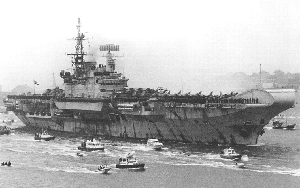
HMS Hermes was later resold to India, becoming INS Viraat and seeing service until… 2017.
The last four derived from the 1942 design were the Centaur class light fleet carriers. They were further improved on many points and much larger, closing on the size of the previous Illustrious class. Otherwise generally similar to the Centaurs, eight hulls were laid down in 1944, the last one being HMS Bulwark (by Harland & Wolff), with HMS Albion, Arrogant, Bulwark, Centaur, Hermes, Monmouth, Polyphemus. However four (Arrogant, Hermes, Monmouth, polyphemus) were cancelled in October 1945, never laid down. The four remaining were seriously modified and launched 1947-53 to carry modern jets. They served for most of the cold war, Hermes seeing action in the Falklands.
Design-wise, they were larger and displaced more, had a better powerplant with larger 3-drum Admiralty boilers for 76,000 shp (instead of 40,000 shp) for 29.5 knots (vs. 25) and carried more oil, 4,000 tons (3,000) and a permanent park of 42 aicraft initially instead of 37, nbut slighlty less with jets in the 1950s. Their armament introduced four twin 4.5 in/45 (114 mm dual purpose guns) MkIII HA and sextuple Bofors plus no less than eleven twin mounts 20 mm Oerlikon, the best of all Britsh carriers so far. Their thick deck proved able to operate 30,000 ibs aircraft while their new catapults could launched this weight at 75 knots. The lifts were larger also and the hangar taller. Overall, all these reasons made them a better fit for extensive cold war modernizaiton and service unlike the previous vessels. Note, that like the Majestic class, these will be treated as a standalone post in 2023.
Conclusion: Disposable ? – Not bad for 50+ years of career

HMS Triumph in 1950
For starters, they were not “Light” carriers, like the American Independence class, as being larger, and officially designed as “light fleet carriers”. An ideal in-between escort carriers and fleet carriers. They were simpler, cheaper and developed with lessons learned culminating with the Majestic sub-class and Centaur class, which is so different it is separated by most authors. Redesigns plagued and extended their construction time so much that in the en only four would be in service in the Royal Navy by eatly 1945, Colossus being the first , had to wait for the others to contitute a coherent unit. So between training and qualification at home, and next acclimatization in the Pacific, they saw little service overall, especially compared to the Illustrious and Implacable classes, which does not really tell anything for their fighting qualities.
The four same Colossus however saw service in the Korean war, and when at home, extensively used as test beds for the latest carrier technology: They notably introduced the Angled deck and Mirror landing system, but their small size precluded the use of larger jets whereas many systems were obsolete. Stripped of funding and materials, the RN was reluctant to invest in their modernization and they were retired by the mid 1960s with the exception of HMS Triumph, converted into a service ship.
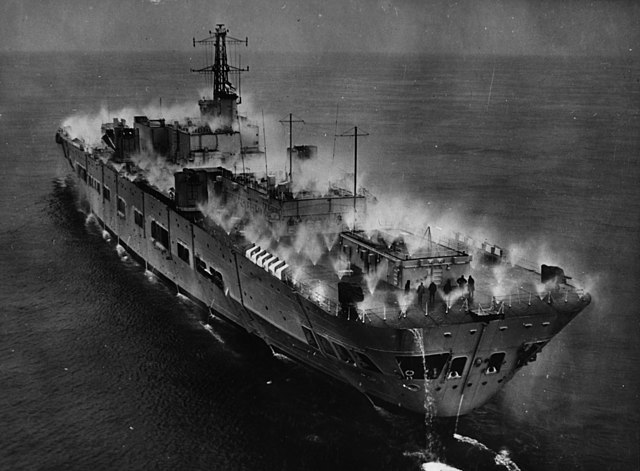
HMS Triumph in pre-wetting trials, 1964, the last active of this class, albeit no longer used as an aircraft carrier.
The four remaining (reserve) Colossus hulls and all five Majestic were only completed to be sold off on the international market. They were delivered brand new with many design updates, and for nations willing to still use piston-powered aicraft, early light jets and helicopters, they had an extensive lifespan due to their pristine state, despite their limitations. Given their price, they equipped many new navies, giving them at least experience in something until then reserved to “great fleets” (such as the US, UK, and Japan). France, the Netherlands, Australia, Canada, Brazil, Argentina, India, all their fleets massively benefited from these carriers. In contrast, the USN sold few of their immense armada of carriers. The mighty Essex class were modrnized and kept into the fleet as long as possible, and in the end only two former Independence class were sold. UK just did not have the budget of the US, but despite this in the 1950s, the country boasted still a large carrier fleet, especially compared to the rest of Europe, some brand new fleet carriers completed by some of the Centaur class.
Scr/Read More

Links
https://www.navypedia.org/ships/uk/brit_cv1_colossus.htm
https://en.wikipedia.org/wiki/1942_Design_Light_Fleet_Carrier
https://www.seaforces.org/marint/Royal-Navy/Aircraft-Carrier/Colossus-class.htm
https://uboat.net/allies/warships/class/164.html
https://www.nationalcoldwarexhibition.org/research/collections/colossus-class/
http://www.naval-history.net/xGM-Chrono-00-ClassInfo.htm#cvcol
https://www.seaforces.org/marint/Royal-Navy/Aircraft-Carrier/Colossus-class.htm
https://www.nationalcoldwarexhibition.org/research/collections/colossus-class/
https://uboat.net/allies/warships/class/164.html
https://www.naval-history.net/xGM-Chrono-04CV-Colossus.htm
https://www.worldnavalships.com/colossus_class1.htm
https://www.abebooks.com/first-edition/Colossus-Class-Aircraft-Carriers-1944-1972-MCCART/1155482894/bd
https://commons.wikimedia.org/wiki/Category:Colossus_class_aircraft_carriers
https://www.navy.gov.au/hmas-melbourne-ii
https://www.navy.gov.au/hmas-sydney-iii
https://www.hazegray.org/navhist/carriers/uk_light.htm
http://3dPlans arromanches/ Colossus on history.de
http://www.maritimequest.com/warship_directory/great_britain/pages/aircraft_carriers/hms_venerable_16.htm
http://www.naval-history.net/xGM-Chrono-04CV-Venerable.htm
https://www.naval-history.net/xDKWD-BPF4512OccupationofChinaCoast1945.htm
https://laststandonzombieisland.com/tag/fleet-air-arm/
http://www.forposterityssake.ca/SB/SB0056.htm
Books
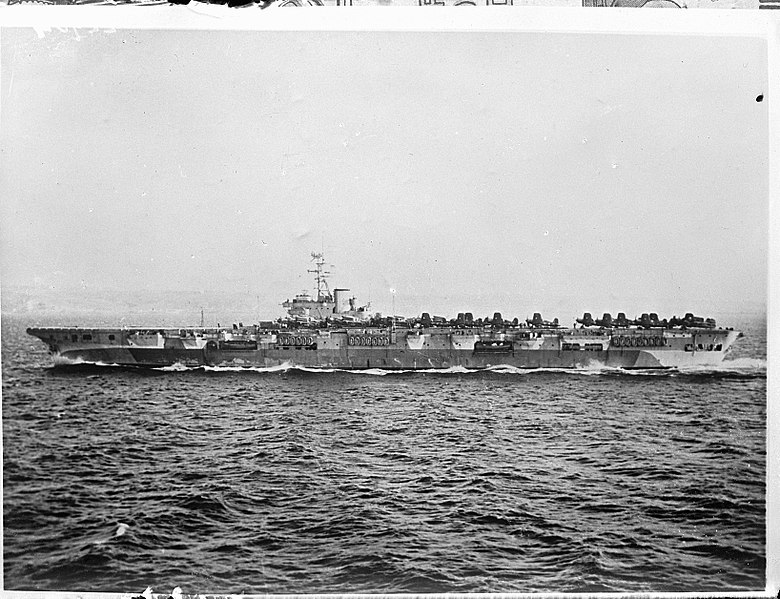
HMS Venerable in 1945
Gardiner, Robert; Chesneau, Roger, eds. Conway’s all the world’s fighting ships 1921-47
Bastock, John (1975). Australia’s Ships of War. Cremorne, NSW: Angus and Robertson.
Bishop, Chris; Chant, Christopher (2004). Aircraft carriers: the world’s greatest naval vessels and their aircraft. Grand Rapids, MI: Zenith
Blackman, Raymond, ed. (1968). Jane’s Fighting Ships, 1968–69 (71st ed.). London: Jane’s Publishing Company.
Donohue, Hector (October 1996). From Empire Defence to the Long Haul: post-war defence policy and its impact on naval force structure planning 1945–1955. Papers in Australian Maritime Affairs (No. 1). Canberra: Sea Power Centre.
Fontenoy, Paul E. (2006). Aircraft carriers: an illustrated history of their impact. Weapons and Warfare.
Hall, Timothy (1982). HMAS Melbourne. North Sydney, NSW: George Allen & Unwin.
Harding, Richard (2005). The Royal Navy 1930–2000: innovation and defence. Routledge.
Hobbs, David (1996). Aircraft Carriers of the British and Commonwealth Navies. London: Greenhill Books.
Hobbs, David (2005). “HMAS Sydney (III): a symbol of Australia’s growing maritime capability”. In Stevens, David; Reeve, John (eds.). The Navy and the Nation: the influence of the Navy on modern Australia. Corws Nest, NSW: Allen & Unwin.
Ireland, Bernard (2008) [2005]. The Illustrated Guide to Aircraft Carriers of the World. London: Anness Publishing.
Konstam, Angus (2010). British Aircraft Carriers 1939–45. New Vanguard. Vol. 168. Bryan, Tony (ill.). Oxford: Osprey Publishing.
McCaffrie, Jack (2007). “Korea: The first challenge for Australian naval aviation”. In Stevens, David; Reeve, John (eds.). Sea Power ashore and in the air. Ultimo, NSW: Halstead Press.
Polmar, Norman (2001) [1993]. The Naval Institute Guide to the Ships and Aircraft of the U.S. Fleet (17th ed.).
Preston, Anthony (2000). Aircraft Carriers. Sydney, NSW: AP Publishing.
Robbins, Guy (2001). The Aircraft Carrier Story: 1908–1945. London: Cassel & Co.
Wragg, David (2009). A Century of Maritime Aviation: 1909–2009. South Yorkshire: Pen & Sword Maritime.
Wright, Anthony (June 1998) [1978]. Australian Carrier Decisions: the acquisition of HMA Ships Albatross, Sydney and Melbourne. Papers in Australian Maritime Affairs. Vol. No. 4. Canberra: Sea Power Centre.
Beaver, Paul (1982). The British Aircraft Carrier. Cambridge: Patrick Stephens.
Friedman, Norman (1988). British carrier aviation: The evolution of the ships and their aircraft. London: Conway Maritime Press.
McCart, Neil (2002). The Colossus-Class Aircraft Carriers 1944–1972. Cheltenham: Fan Publications.
Videos
HMS Warrior recommissioned for the Korean War – British Pathé
Model Kits
General Query on Scalemates
Special mention for Southern Cross Models which provides a gargantuan 1/72 hull for you to scratch-complete, in Australia.
1:700 IHP hms colossus 1945 Kit review
Building a 1:144 HMCS Bonaventure on carrierbuilders.net
The Colossus class in service
This chapter will focus on their British service, in WW2 or afterwards and not on their national career under other flags, with just succint mentions of their fate. Arromanches, Karel Doorman, Veinticinco de Mayo, HMAS Vengeance, Minas Gerais, HMCS Warrior, Independencia would have their own dedicated post in the future. The years given are for the launch date.
 HMS Colossus (1943)
HMS Colossus (1943)
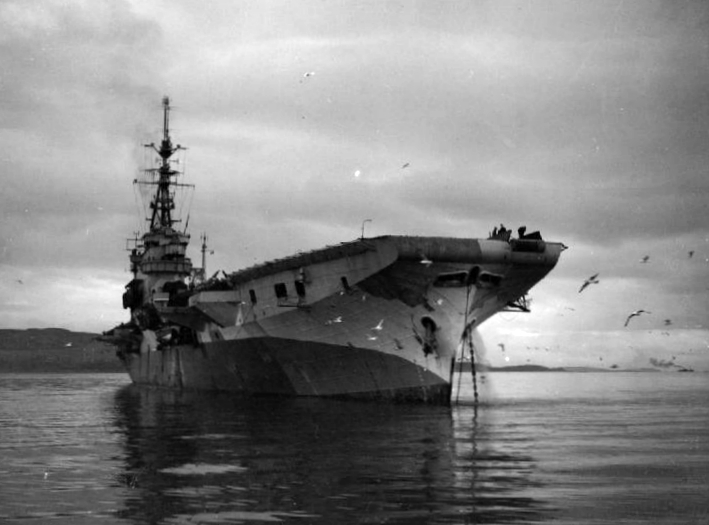
HMS Colossus(R15) at Greenock c1945
WW2 service
After completion on 16 December 1944,HMS Colossus made her shakedown run and fixes close to the yard in January-March, under command of Captain G.H. Stokes. She left Glasgow on 12 March 1945 for the Far East, with 24 Vought Corsair IV fighters freshly arrived, from 1846 NAS plus 18 Fairey Barracuda Mk.II torpedo bombers from 827 NAS. She sailed south to the Channel, Gulf of Gascony, Spanish coast down to Gibraltar, then crossed the Mediterranean, the Suez canal, and arrived at Colombo in Ceylon on 13 June 1945.
On 7 Jul 1945, she was escorted underway by the battleship HMS Anson from Trincomalee for Fremantle after conducting refuelling exercises off Trincomalee. With HMS Vengeance and Colussus she arrived in Fremantle, joined underway by HMS Venerable (flagship, Rear-Admiral R.J.H. Harcourt) from Colombo and later joined by HMS Anson, which refuelled destroyers en route.
after arrival on 16 July 1945, HMS Anson escorted HMS Venerable, Vengeance, Colussus and the destroyers HMS Tyrian and Tuscan for Sydney. They all arrived at Sydney in the morning of 22 July except Tuscan (afternoon) and HMS Colossus which which entered Jervis Bay a bit earlier than the others.
Sydney, Australia, was the rear operating base of the BPF, and the unit was worked up throughout the remainder of July. Upon arrival, she saw her 20 mm Oerlikon guns replaced by single 40 mm Bofors guns and by August she became flagship, Rear Admiral Cecil Harcourt at the head of the 11th Aircraft Carrier Squadron with her sisters HMS Venerable, Vengeance, and Glory. The war ended as they were underway.
The first operation was a sortie to re-occupy Hong Kong (19 August), and together with Colossus were the carrier HMS VENERABLE, the cruiser SWIFTSURE, EURYALUS, the monitor PRINCE ROBERT and the destroyers KEMPENFELT, URSA, WHIRLWIND and QUADRANT under the operational name of Task Group 111.2 under orders of Rear Admiral Cecil Harcourt.
She was the floating HQ for the occupation task force on Shanghai with the cruisers Bermuda and Argonaut, plus five destroyers. She was alone as the head of Task Group 111.3 with HMS BERMUDA (Flying the Flag of Rear Admiral Servaes, Flag Officer Commanding 2nd Cruiser Squadron). Argonaut as said, plus the destroyers TYRIAN, TUMULT, TUSCAN and QUIBERON.
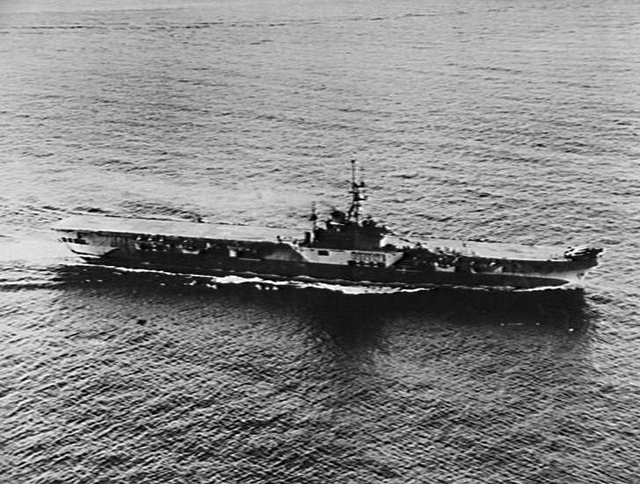
HMS Colossus (R15) off Shanghai 1945
Cold War service
In December 1945, HMS Colossus carried Dutch POW back to Colombo. On 17 January 1946, Colossus arrived off Cape Town to fly off her Barracuda and Corsair to Naval Air Station Wingfield, prior to drydock refit in the Selborne dry dock of Simonstown. Refit was carried out notably to repair her damaged bow. On March 26th she was floated out, and went on with the refit at berth until April, sailed around Cape Point, Table Bay, recuperating her Corsair from RNAS Wingfield base. One however during landing operations veered to port and ditched to the sea. The pilot was rescued by the frigate HMSAS Transvaal close to her as safety ship.
In July 1946, she had completed her first tour of duty in the Far East. On 6 August, HMS Colossus was transferred to France, for a five year loan. She was recommissioned in Toulon under the new name “Arromanches” (A beachead in Normandy, part of the British landing zone “Gold”). In 1951, Arromanches was officially purchased as the loan expired, after two deployments to Indo China. She would make two more deployments until 1954. Later that same year she was back in the Mediterranean and took part in Suez operations flying Corsairs and Avengers. In 1957-1958 she was completely refitted, following British advances, with a 4° angled flight, mirror landing device. She would ne refitted again in 1968 as a multirole helicopter carrier and serve until 1974, BU in Toulon 1978. A full article will be written on Arromanches in the future.
 HMS Glory (1943)
HMS Glory (1943)
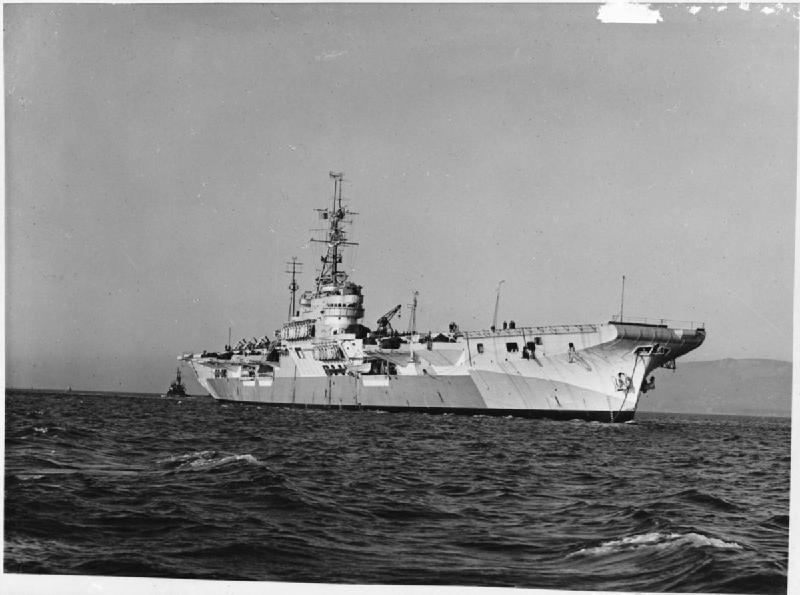
HMS Glory was commissioned on 2 April 1945, and spent the rest of her time working out and receiving with her Barracudas from 837 NAS and Corsairs from 1831 NAS. While at Sydney, she joined the 11th Aircraft Carrier Squadron, BPF, under command of Anthony Wass Buzzard.
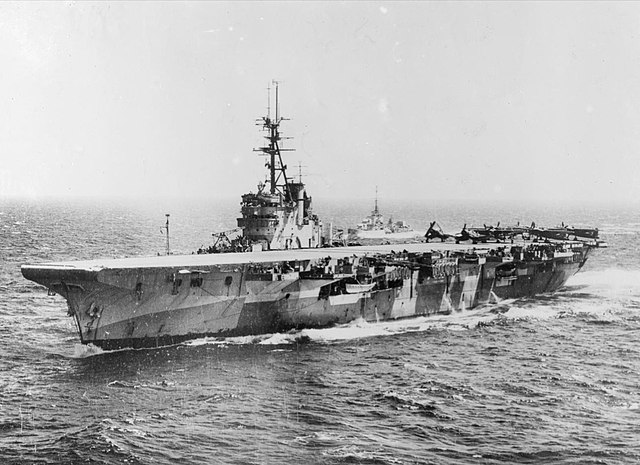
HMS Glory (R62) with HMS Wizard (R72) in the Pacific, August 1945
The unit never really had the time to operate and arrived in Rabaul shortly after the end of the war, on 6 September 1945, accepting the surrender of the Japanese garrison there while other carriers of the same units were dispatched to to do the same at Hong Kong and Shanghai. She had on board Charles Causley, Cornish poet and broadcaster acting as Chief Petty Officer Coder, which wrote ‘The Song of the Dying Gunner AA1’ and two other pieces, ‘HMS Glory’ and ‘HMS Glory at Sydney’ describing notably the Japanese surrender.
After Rabaul, Glory arrived for the same in Hong Kong, and returned Australia. There, she took on board Commonwealth troops to their respective countries, starting with Canada. After this british “magic carpet” operation she was back home in 1947, to be placed in reserve. In November 1949, she went out of reserve, reconditioned to fill service by December 1950 as the war in Korea broke out.
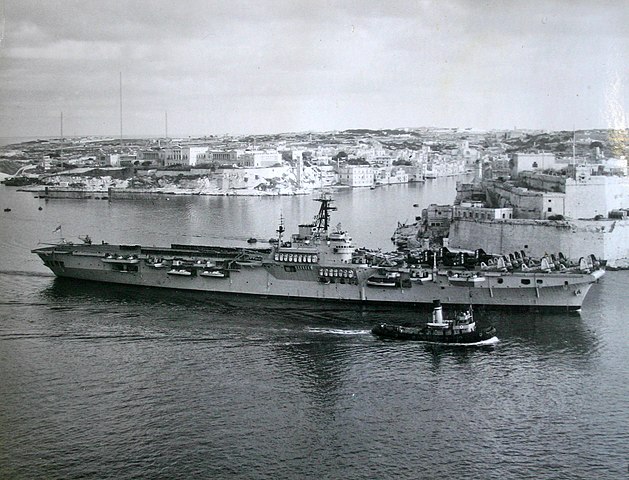
HMS Glory in The Grand Harbour, Malta 1954
She made a first tour of duty in by April 1951, the first of three. This first deployment saw heavy action and ended in September. She was back again in Korea from January to May 1952. Her third tour was between November 1952 and May 1953. After this, she served from 1954 as a ferry and troop carrier, but also helicopter base, back home. She started to experiment helicopter warfare. However due to the budget cuts of the time, by default of a resell, in 1956 the admiralty signed her planned retirement. She was sent in reserve, until 1960 when written off, sold for BU in 1961, Glory to Thos. W. Ward and scrapped in Inverkeithing.
 HMS Ocean (1943)
HMS Ocean (1943)

After commission on 8 August 1945 (she was built at Stephen & Sons, Scotland) she departed to Cammell Laird, Birkenhead for modifications. The admiralty planned to use her to operate night fighters which included a new US-built SM-1 radar in place of her Type 277 height-finding one, as well as improved direction-finding system.
She departed in November 1945, completely missing operation on the Pacific and the end of the war, or any meaningful wartime operation. HMS Ocean was sent to Rosyth for flying trials and test her new equipments, and notably qualifications of her new De Havilland Sea Hornet air group, but also -amazingly- of her radar, night-capable Fairey Swordfish.
On 3 December 1945 she was the first to see a De Havilland Sea Vampire (flown by superstar test pilot Eric “Winkle” Brown) for a first ever jet carrier landing, on HMS Ocean. This was a world’s first as back in the US the composite Ryan FR-1 Fireball made the same.
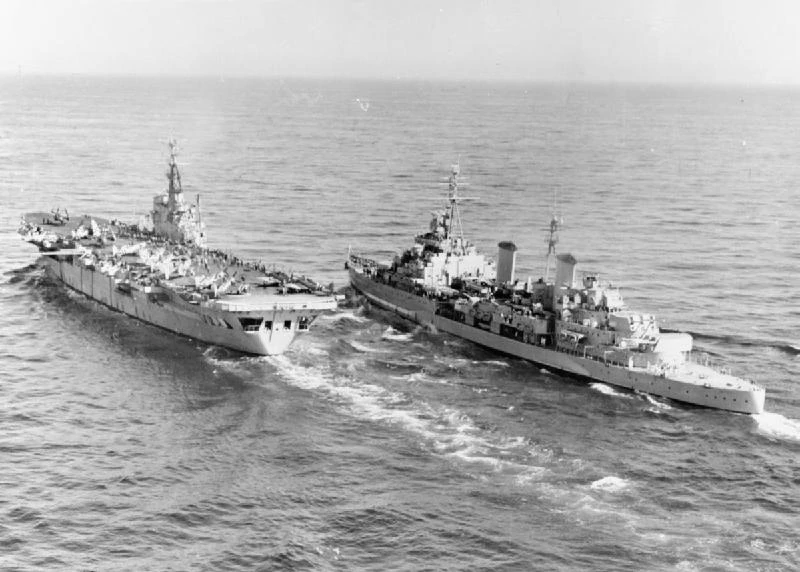
HMS Belfast and HMS Ocean
In December 1945, Ocean departed for the Mediterranean Fleet. It had a mixed air group of very late pist-on powered models, the Supermarine Seafire Mk.37 (805, 816 Naval Air Squadrons) and modified Fairey Firefly as night fighters. She disembarked this air group at Malta, in June 1946, and was converted as troopship, bound to Singapore. From October 1946 she provided support to the destroyers HMS Saumarez and Volage damaged by mines in the Corfu Channel incident. In May 1948 she took the head of a task force supporting British troops withdrawal from Palestine and provided air cover for the also evacuated RAF bases there.
Next came the war in Korea: HMS Ocean made two deployements in May-October 1952 and May-November 1953. In August 1952, her onboard Hawker Sea Fury engaged incoming North Korean MiG-15 jets and one was shot down. It was one of the only rare dogfights between jets and piston-powered models and HMS Glory, again, inaugurated a “first” of the kind. In August 1954, she joined the Home Fleet’s training squadron. Soon however she was prepared for a new action, the Suez crisis.
She was converted and prepared to act as impromtu assault ship, helicopter carrier. She inaugurated the first ever large-scale heliborne assault with Westland Whirlwind and Bristol Sycamore onboard, together woth HMS Theseus: Both landed 425 men, 45 Commando and 23 tons of equipments dirtectly into Port Said, in a mere 90 minutes. Back home, her active service saw nothing notable in 1956 and by September 1957, she visited Helsinki, prompting complains of the USSR. This was her last overseas deployment. Back home, she entered extended reserve in 1958. In 1961 she as written off, and sold for BU, scrapped in 1962 at Faslane.
 HMS Venerable (1944)
HMS Venerable (1944)
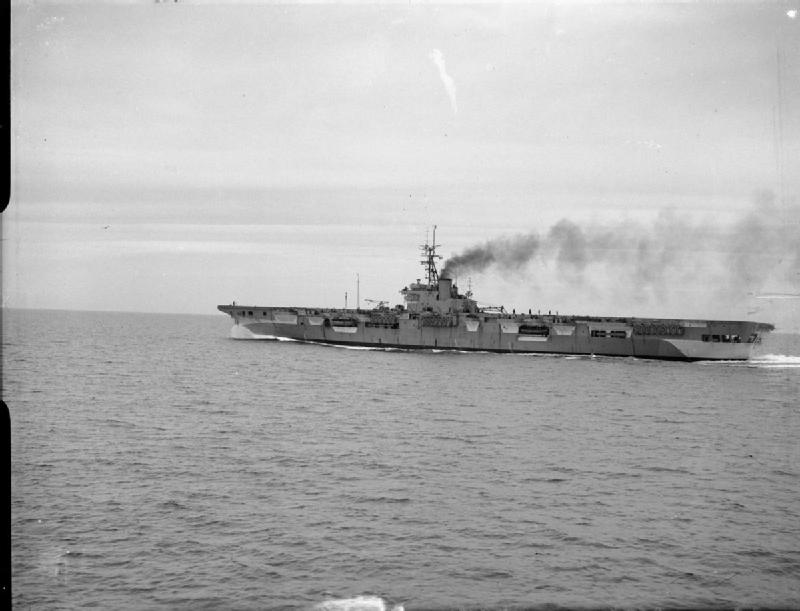
HMS Venerable in 1945
HMS Venerable (R63) was completed at Cammell Laird on 17 January 1945, second of the class after Colossus. She was worked out for her sea trials, post-trials fixes, and made a short shakedown cruise with intensive training, prepared to join the BPF in the Pacific. She sailed for the Far East as soon as possible, joining the 11th Aircraft Carrier Squadron with her sisters Colossus, Glory and Vengeance, loaded with forty F4U Corsair fighters and Fairey Barracuda on board. compléter !!!!!!!!!!!!!
Cold War Career:
In 1948, she was sold to the Netherlands as HNLMS Karel Doorman, taking part in the 1962 in Western New Guinea. The format of the Dutch Netherlands Navy was reviewed down afterwards, and after her 1968 boiler fire she was repaired, overhauled but resold to Argentina, renamed ARA Veinticinco de Mayo. She famously took part in the Falklands War. By 1990, declared inoperable she was resold to be cannibalized to the Brazilian Navy, operating Minas Gerais of the same class. Her gutted hull was eventually sold for BU, scrapped in Alang, India in 2000. Both Karel Doorman and Veinticinco de Mayo would be seen in their own dedicated posts.
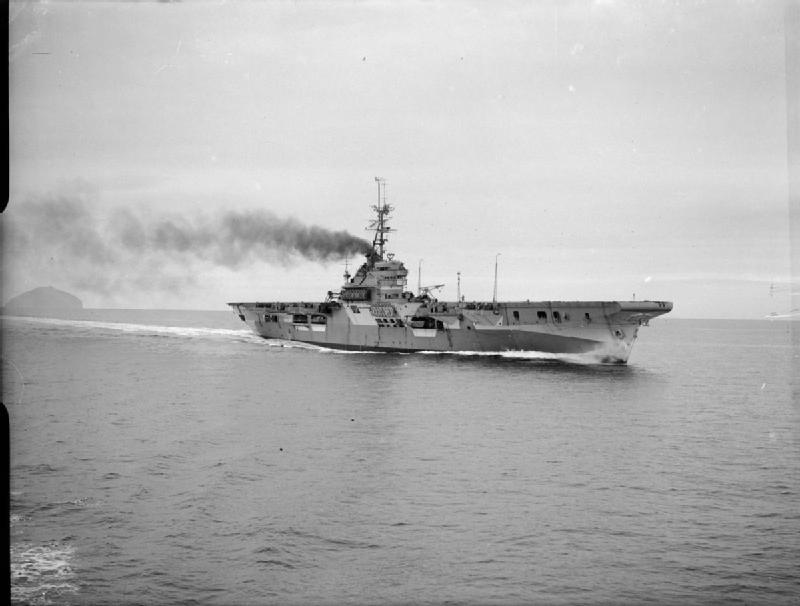
HMS Venerable in 1945, other view

HMS Venerable in 1947
 HMS Vengeance (1944)
HMS Vengeance (1944)
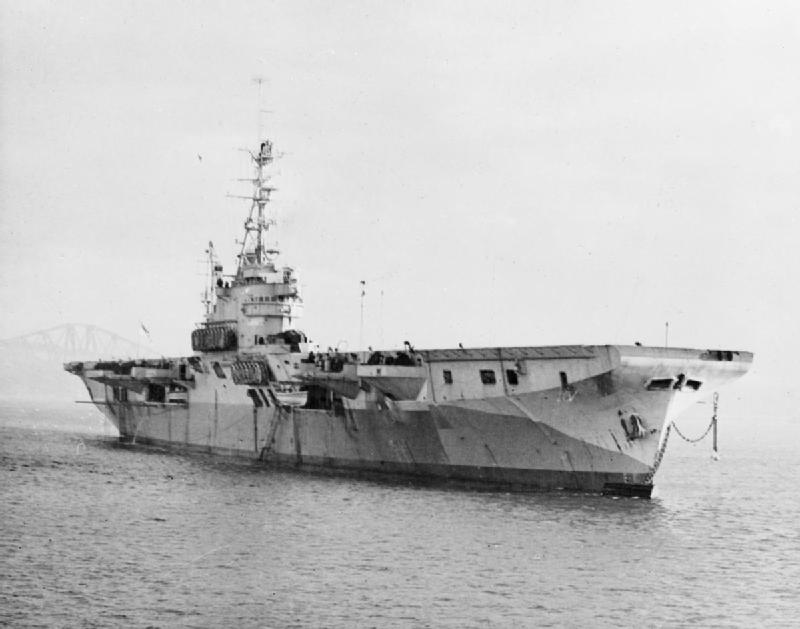
WW2 service
HMS Vengeance (R71, Commisionned 15 January 1945) was only ready by 11 March 1945 when she left the River Clyde (Built at Swan Hunter) for her working-up trials in the Mediterranea, Malta, before proceeding to the far east. These trials were completed on 21 May so she assigned to the 11th Aircraft Carrier Squadron, BPF.
From Alexandria and Port Said she arrived to Trincomalee in the Indian Ocean before proceeding to Fremantle and Sydney, on 26 July. There, she had eight Oerlikons replaced with Bofors 40 mm guns and she was assigned to Task Group 111.2 to attack Truk. However as she was prepared, war ended on 15 August, while still in Sydney. Instead she was dispatched in Hong Kong for the Jpanese surrender and covering the occupation force, and was present on 3 September as the place was this surrender took place.
She was still there until December 1945, before proceeding to Austrlia for her refit, and came bacj afterwards to Hong Kong, only departing later for another mission: She landed in April 1946 No. 11 and No. 17 Squadrons RAF to Miho, Ibaraki in Japan, assigned to the British Commonwealth Occupation Force of the achipelago. She was assigned there until 20 July 1946 and departed for home, Devonport, reached on 13 August after stopping in Trincomalee. By December 1946 she was sent in Scotland to serve as a training carrier.
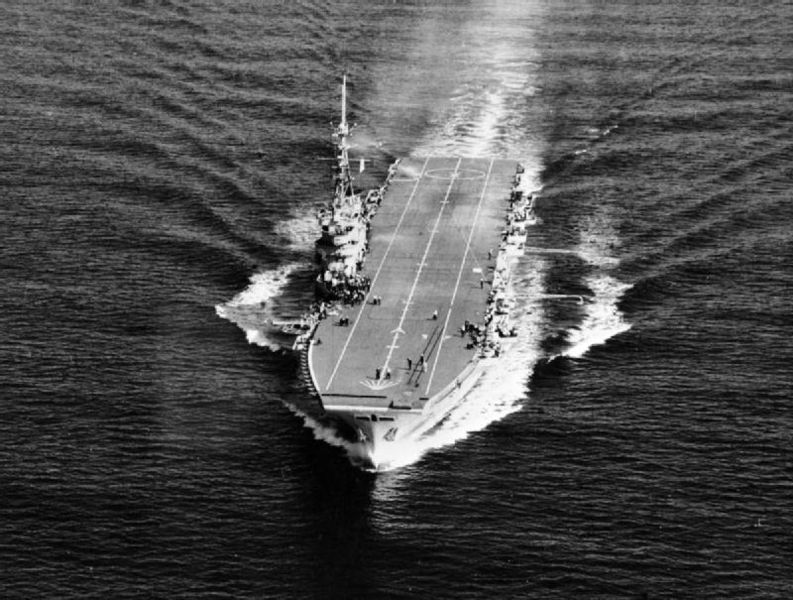
HMS Vengeance (R71) underway in 1945
The cold war
During this career she brought cadets to Oslo and Trondheim in June 1947, hosting First Sea Lord Sir John Cunningham and by early 1948, joined the 3rd Aircraft Carrier Squadron of the Home Fleet. She visited St Helena island in October and then led the Squadron to South African by November. After reutrning home she was converted for Arctic conditions. From 5 February to 8 March 1949 she took part in Operation Rusty, a little known experimental cruise in Arctic waters, testing the fleet in extreme cold. It reflect a similar USN operation HighJump in 1947. Seems common objectives were also how to wage war on USSR under these latitudes.
By June 1951, Australian Defence Committee recommended the acquisition of another carrier on loan while waiting for HMAS Melbourne (freshly renamed and in completion at the time, 21 months beyond schedule) was ready. The RAN looked for a four-year loan, from late 1952 to late 1956, until HMAS Melbourne would be fully operational, while upgrading HMAS Sydney, and modified to operate the Sea Venom and Gannet dyring the Sydney upgrade. However the British Admiralty announced that for these, the installation of a new arrestor cable system would further delay introduction, and based on Australia’s taxpayer money.
HMS Vengeance was selected for this loan and minor modifications were complete by January 1952, with the crews locally drawn from the just reserved light cruiser HMAS Hobart. Australia paid the modifications and operational costs, not the loan, which started by mid-1952 when the liner Asturias carrying the intended crew arrived in UK. The rest of her carrer, as HAMS Vengeance started from 13 November. She became a TS by 1954 and was decommissioned on 25 October 1955 to prepare crews for HMS Melbourne. Her motto was: “I Strike I Cover”.
Afterwards, she was underway for UK by June, stopping in Singapore to collect RN helicopters and arriving on 13 August before decommission, her crew being repatriated onboard HMS Melbourne commissioned on 28 October.

HMS Vengance with her new flight deck before transfer to Brazil, 1960
HMS Vengeance was not reactivated. Instead on 14 December 1956, a contract was signed wit Brazil for a hard sell to US$9 million. From mid-1957 until December 1960 however, she was compehensively refitted and reconstructed at Verolme Dock, Rotterdam at US$27 million (to compare to the purchase cost). She notabkly earned a 8.5° angled flight deck, better steam catapult, arresting gear, and reinforced hangar lifts, better mirror landing system and other modifications to operated jet aircraft. The superstructure was changed also with a new lattice, new radar suite, fire control system.She also had new Boilers, all the electric al system was overhauled, expanded and converted to AC power. She was commissioned as NAeL Minas Gerais on 6 December 1960, arrived in Rio by January 1961 and after a well fill new career, ended service with a decommission on 16 October 2001, the last ever WW2 aircaft carrier in service.
 HMS Pioneer (1944)
HMS Pioneer (1944)
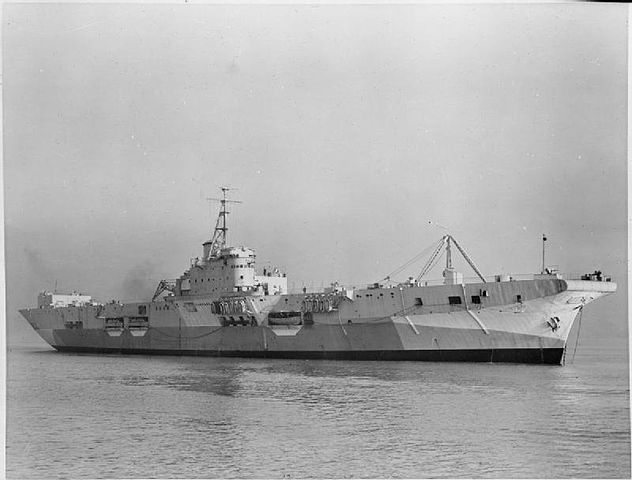
HMS Pioneer (R76) was completed at Vickers on 8 February 1945. She was fitted out and commissioned as an aicraft repair ship, part of the “supply and maintenance train” of the British Pacific Fleet. She was worked up to shape and without time to make a proper shakedown cruiser, was rushed for Australia on 30 March 1945 via the Mediterranean and Indian Ocean, arriving in Sydney on 13 May, to be prepared and transferred to Manus Island (Admiralty Is.) on 21 June, preparing for the last operations on the coast of Japan.
However she was still in Manus when the Japanese surrendered on 15 August. Meanwhile she received 24 aircraft and repaired them. She was later sent to Hong Kong by late September, helping with rebuilding infrastructures. Her well tooled crew restored power, telephone, transports, cleared streets. Afterwards she returned to Manus to resupply and was back for the same mission in Hong Kong by late November. She then departed for Sydney in December and stayed there during Xmas and the new year for the crew’s first leave, until departing for UK on 17 February 1946. She was placed in reserve on arrival, and amidst 1950s budget cuts and without much interest for export, she sold for BU to Thos. W. Ward in September 1954, broken up in Inverkeithing, having the shortest career of any Colossus class carrier.
 HMS Warrior (1944)
HMS Warrior (1944)
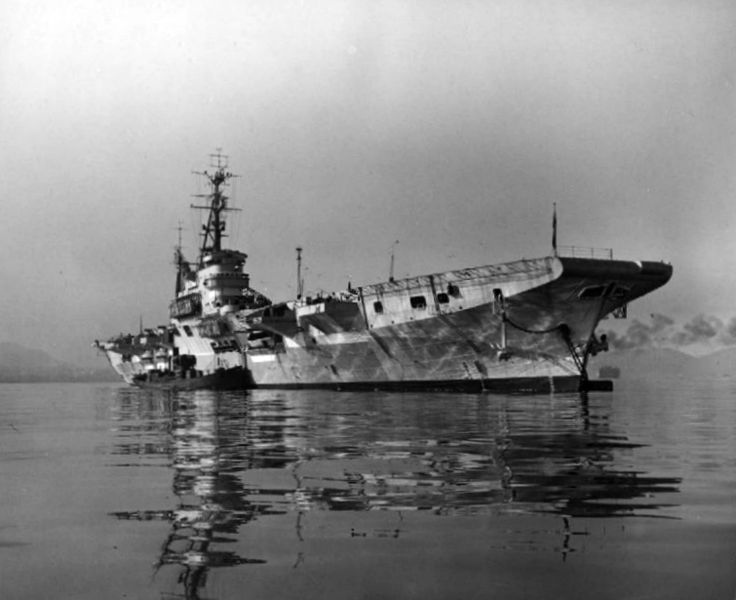
Planned for the far east campaign
HMS Warrior was at first laid down and intended for the RN, but as construction went on at Harland & Wolff, by May 1944 it was already clear that the European theater was now settled and the Royal Navy was to focus on the Pacific. Therefore, focus shifted to this theater and at the same time, the general staff of the Royal Canadian Navy, now freed from most of the fighting in the Atlantic, which was mostly over, thought how to contribute to operations in the Asian theater as well, calculating it would required a larger fleet, both in numbers and size.
The RCN planned to return its escort carriers on loan, HMS Puncher and Nabob to the RN in exchange for loaning two of the new Colossus light fleet carriers in completion. Negociation started by July 1944 but they were only finalised in April 1945: The RN staff decided to allocate HMS Warrior and Magnificent on loan, with a purchase option at a later date. Negotiations followed for the air group deliovery and ended in May for what naval air squadrons would be needed, but in between, both vessels were completed, HMS Warrior by 2 April 1945.
HCMS Warrior (1946)
The air groups of the new Canadian naval aviation were materialized through the creation of four squadrons, transferred from the Fleet Air Arm, all for HMS Warrior: The 803, 883 Squadrons (Supermarine Seafires) 825, 826 Squadron (Fairey Firefly). HCMS Warrior was eventually transferred, but the war ended in between. She was indeed only commissioned by 24 January 1946, and so never ventured in the far east as intended. She was under command of Captain Frank Houghton during her Sea trial, completed in March 1946, then qualifications performed at Spithead in April. When steaming to Canada she carried only 803 and 825 Squadrons (One of each type). 883 and 826 Squadrons were paid off instead, amidst budget cuts.
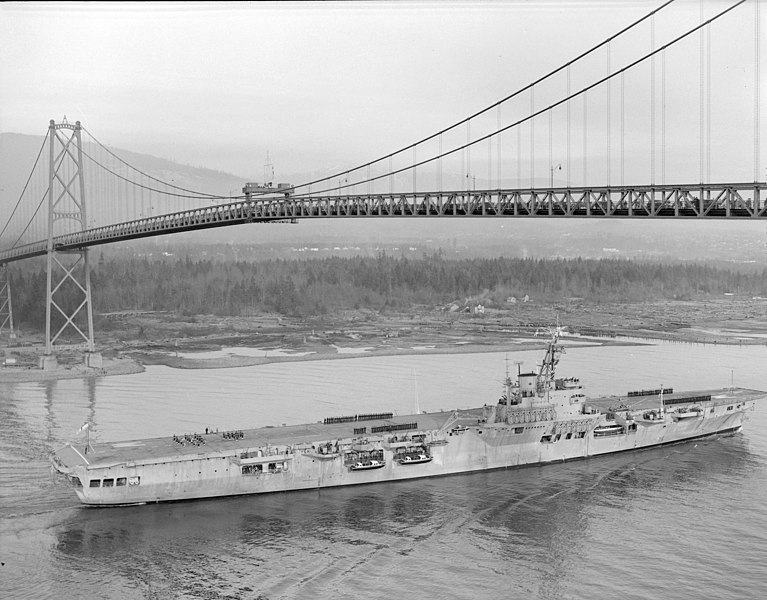
HMCS Warrior passing under the Lion’s Gate Bridge
HCMS Warrior arrived in Halifax on 31 March 1946, escorted by HMCS Micmac and the minesweeper HMCS Middlesex, assigned to the Canadian Atlantic Fleet on 23 March. April-May were spent in yard fixes, and she started major fleet operations, with a first accident in August, a Firefly from 825 Sqn ditching when landing, pilot and observer rescued. On 23 August while transiting St. Lawrence River, she ran aground at Pointe Sainte Antoine near Montreal, after her rudder jammed. Tugboats eventually had her unstuck and she resumed her trip to Montreal, being the largest ship ever visiting the old French Canadian City.
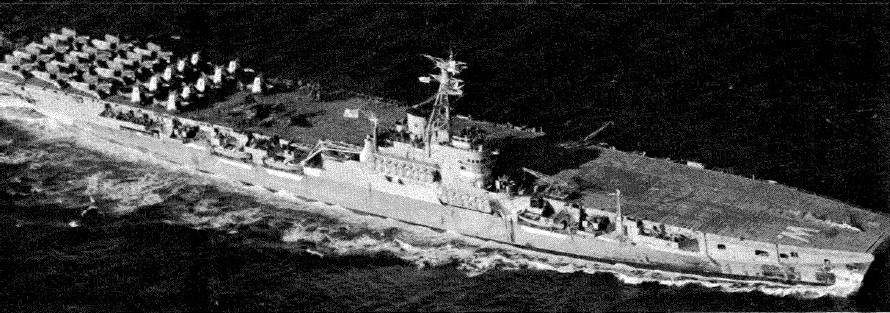
HMCS Warrior in Vancouver, British Columbia
The RCN however soon realized she carrier was not optimal for great cold operations, lacking heating equipment for effective service in the North Atlantic waters. She she was transferred to Esquimalt in British Columbia by November 1946, for a round of Pacific service. She made a long trip south, via Bermuda, Acapulco, Mexico and San Diego in California, where she arrived by December.
On 18 January 1947, Commodore Harry DeWolf became her new captain while undergoing repairs (for her St Lawrence grounding). On 31 January, she lost another Firefly off Portland Island. However soon further budget cuts had the Canadian admiralrt review its loan and concluded they could no longer operate two aircraft carriers which would become obsolescent. Negotiations to return them were assorted by the fact the RCN considered Warrior unfit due to the lack of heating. By February 1947 she returned to Halifax and was prepared to depart for UK escorted by the cruiser HCMS Uganda and destroyer HMS Crescent.
Back to the RN and rubber deck trials
The “task force” transited the Panama Canal and were escorted out by the Canadian destroyers Nootka and Micmac, visiting Havana in Cuba and bacl to Halifax on 27 March, sailing afterwards to Bermuda with HMS Nootka for her last naval exercise with the Royal Navy, and next an overhaul in Halifax, plus exercises alons the east coast. By August she was back in UK to received new squadrons with Firefly IV and Hawker Sea Fury, and returned tp Halifax on 28 August 1947. HCMS Warrior escorted by Haida sailed to Bermuda to be paid off and departed for UK on 12 February, arriving at Belfast on the 20th and on 1st March to Spithead to have her aviation fuel removed. She was retintegrated officially in the Royal Navy on 23 March 1948, at Portsmouth.
As HMS Warrior she was modernized in drydock at Devonport: She received a new “flexible” flight deck, testing undercarriage-less aircraft with modified De Havilland Sea Vampires, successful but not implemented for service, with its ingenious rubber sheet supported by air bags, extending from the bow to the barrier forward of the island over the existing flight deck. Aft of it was located akso a a light steel ramp 2 feet 6 inches (0.8 m) high and single arrestor wire. Trials were over by March 1949 and the carrier was paid off, reserve, in Portsmouth.
HMS Warrior in Korea-Indochina
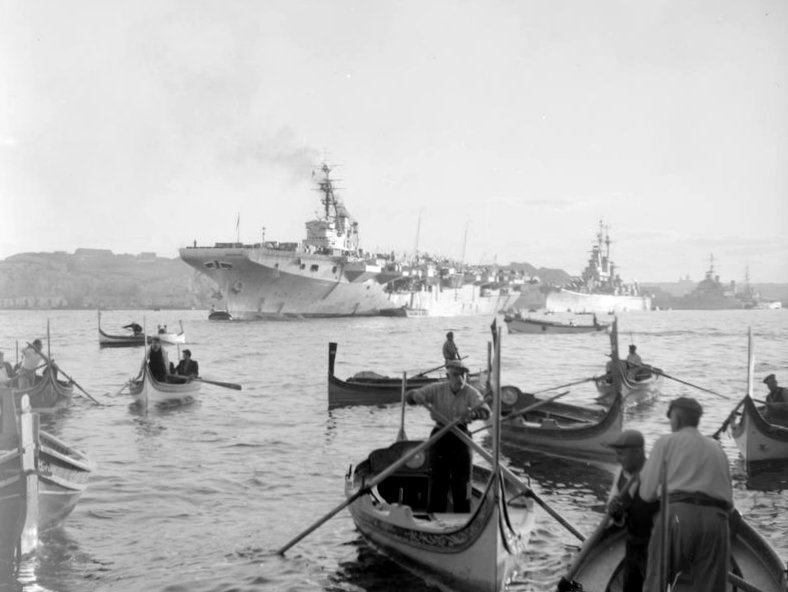
HMS Warrior, USS Des Moines and HMS Gambia at Malta, 1951 (IWM)
Reactivated in June 1950 this time she was modified to carry troops and aircraft to the Far East: This was the start of the Korean War. She departing in August for her first tout of duty and sailed back home. By June 1951 she was sent to the Mediterranean, again carrying aboard troops (in that case the 16 Parachute Brigade). They headed to Cyprus, as the middle east crisis developed. Back home, HMS Warrior was refitted in 1952-1953 in Devonport drydock, modernized: New, strong lattice mast for new radars, Type 281Q and Type 277Q radars, IFF (Identification friend or foe) aerials, enlarged bridge, enclosed. When done, she prepared qualifications of the FAA 811 Squ. (Sea Fury) and 825 Sqn (Firefly) after her sea trials.
She made another tout of duty off Korea in 1954, patrolling the coast after the ceasefire. At the same time, the Indochina war was all but lost by the French and negociation soon ended with a separation between north and south, which also provoqued reprisals and refugees in the north. By September, she took part ot Operation Passage to Freedom, evacuating anti-Communist refugees from Haiphong in North Vietnam, to Vung Tau in South Vietnam (3,221 in two trips). Later her captain was awarded the South Vietnamese Presidential Citation.
Her last service leg
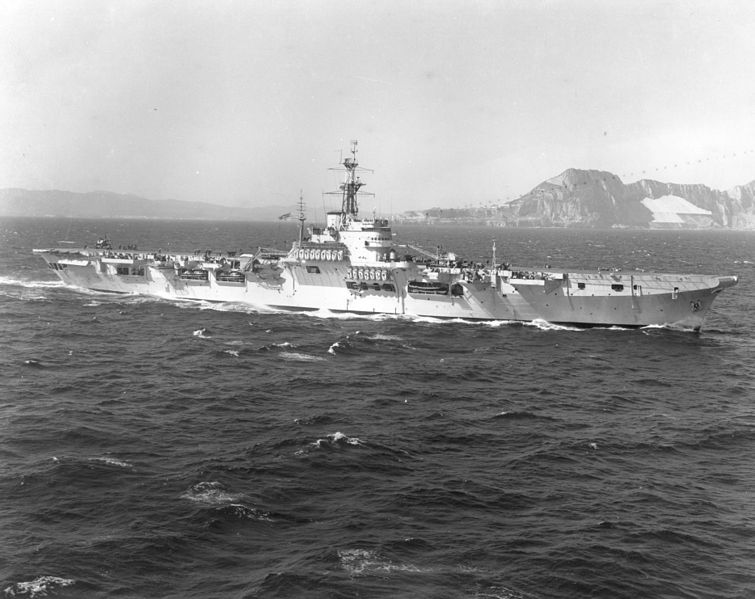
HMS Warrior (R31) in the 1950s
Back home, she was teken over for her last refit in 1955 at Devonport, this time to operate jets, with the same modifications as comparable carriers of her class:
-Angled flight deck, 5° portside amidships
-Portside sponsons removed
-Reinforced deck to support 20,000 pounds (9,072 kg) jets.
-Catapult upgraded to launch 20,000-pound aircraft
-Arrester wire system improved to stop the same at 60 knots (111 km/h).
-Reinforced lifts for the same standard
-New modern mirror landing aid system
-New Type 961 CCA radar.
It was intended to turn her as training and trials vessels for further upgrades to other ships of the class (and Majestic class).
She acted first as training ship until dispatched to the Pacific for Operation Grapple as the ship HQ for the first British hydrogen bomb tests. She operate a flight of Westland Whirlwind helicopters and Grumman Avenger AS4 aircraft, collecting air samples for lab tests. Before departing, the Avengers were thrown into the sea, contaminated as well as surplus to requirements. Back home, HMS Warrior was decommissioned in February 1958. She was offered for sale, notably when transiting via Argentina, and making more port visits and demonstrations in the country as a bid to concluded a sell.
As ARA Independencia

ARA Independencia, showing her brightly colored Texan trainers. Src. Taringa via pinterest
This proved fruitful as the government accepted the request and she was sold, renamed ARA Independencia, officially transferred on 6 August 1958. But back in the UK, and the ensign was only raised on 4 November at Portsmouth, time for her to receive her assigned crew and returned to Argentina on 10 December. The Argentine Naval Aviation started qualifications on 8 June 1959, and official commission was done on 8 July 1959. At the time she only carried eight Bofors but by May 1962 she earned a quadruple and nine twin Bofors in addition.
She also had a new air group befitting on her 1955 modernization: She carried 24 aircraft, a squadron of Vought F4U Corsairs, completed by North American SNJ-5Cs Texans and Grumman S2F-1 (S-2A) Trackers. Soon she also adopted a flight of Grumman F9F Panther from August 1963 and TF-9J Cougar, but only for tests as they proved unsuitable. She also later received NA T-28 Trojan trainers in replacement of her Texans. However as the more modern ARA Veinticinco de Mayo entered service in 1969 she was placed in reserve the next year and scrapped in 1971.
 HMS Theseus (1944)
HMS Theseus (1944)
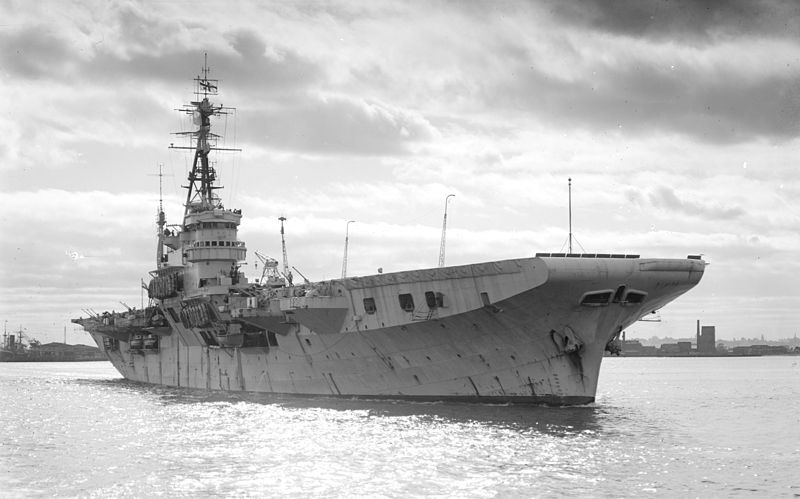
HMS Theseus was not completed before peace came up by August 1945. After working up and post shakedown fixes, she went through basic training to be used as a training vessel basically until the Korean War.
In 1946, she conducted aircraft qualification and a large battery of trials without the emergency of being sent to the Pacific. Operational service really commenced by late 1946, after being prepared for a first our of duty in the Far East and join the British Pacific Fleet based at Singapore. She was to act as Flagship, Flag Officer Air, Far East. In 1947, she hold the same role but as the 1st Aircraft Carrier Squadron, BPF. On her return home she was refitted for Home Fleet service and after completion joined the 3rd Aircraft Carrier Squadron at Scapa Flow.
HMS Theseus in the Korean War
In 1950, she was deployed to Korea for standard carrier operations, suppressing enemy defences and communications at Chinnampo and other sites, and for her second mission, provided Combat Air Patrols. It happened her dysfunctional catapult was unable to launch heavily armed aicraft as intended. Her third mission was as part of the Commonwealth Task Force, reaching Sasebo in Japan. Back in Korea she launched powerful air strikes on bridges, troops concentration or multiplied patrols in search of opportunity targets mostlu around the Chinnampo area.
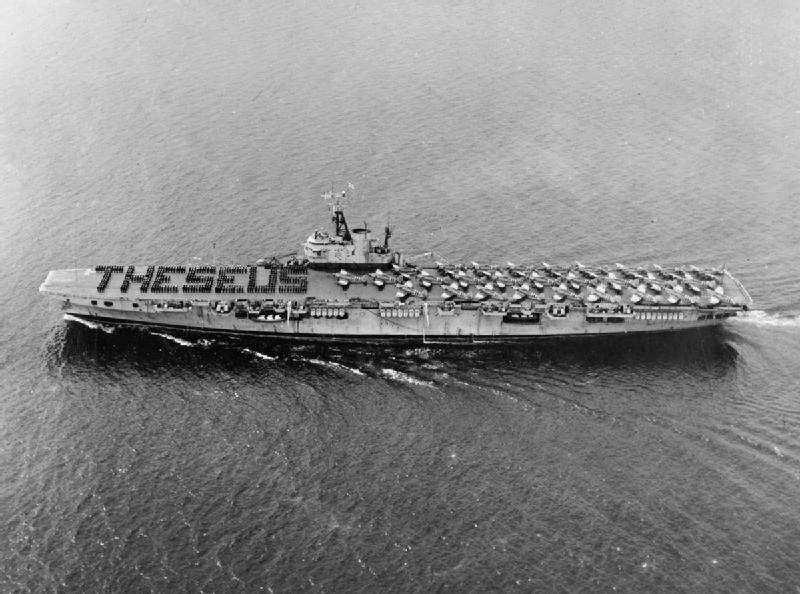
HMS Theseus off Japan, 1951
During her fourth operational patrol from December 1950, a single Fury with rockets rampaged land gathered Chinese vehicles in heavy snow. Later Chinese troops were “visited” daily by her air group. After her fourth tour had had 1,630 hours under her belt, with 1,400 rockets spent.
From 5 January 1951 after some rest at Sasebo and resplenishment, HMS Theseus resumed operation for her her fifth patrol, this time in close support of the American 25th Division south of Osan (South Korea). On 15 January, was celebrated her 1,000 accident-free landing. Her Carrier Air Group were awarded the Boyd Trophy afterwards for its achievements. She made a sixth operational patrol by late January, with some accidents. On 26 January one landing aicraft spinned out of control into the sea, no suvivor coulkd be located by her escort HMS Cossack. A second was one short down by AA fire, the pilot bailing out off Tongduchon-ni and rescued by a USN helicopter 90 minutes later. On 2 February, a Sea Fury burst a tyre while landing.
HMS Theseus’ seventh operational patrol saw a casualty by Firefly gun misfire, and intensive close air support for the U.S. IX Corps, Wonju area. The eight patrol started on 4 March 1951, in the area of Chinnampo to Kuhsa-Sung, as a diversion for a fake amphibious assault. She had two more crashes and her ninth patrol on 24 March saw one Fury shooting down a Mig. One day, a squadron attacked and rampged six North Korean vessels.
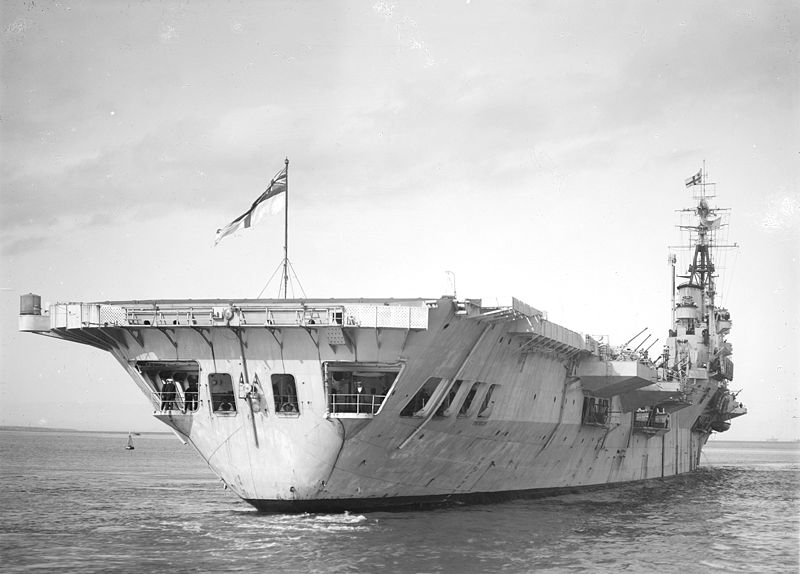
HMS Theseus
The tenth patrol was her last of this war. It started on 8 April 1951, from the Sea of Japan and with the carrier USS Bataan, and a combined allied destroyer screen (HMS Consort, HMAS Bataan, HMCS Huron, USS English and USS Sperry). On 10 April, two Sea Furies shortly duelled with USN Corsairs in a friendly-fire incident. One was seriously damaged while in reconnaissance duties. Another was shot down and the pilot taken prisoner, down by flak, but later escaped capture. Two more were shot down trying to locate him. If the first was soon rescued the other, injured, had to flee his North Korean purusers under fire of a Sea Fury remaining as close support before a helicopter arrived some 38 minutes later.
More strikes would follow and Theseus deplored another aicraft shot down. The American helicopter pilot that picked the pilot up under heavy fire was later awarded the DSC for outstanding bravery at the British Consulate in Seattle on 15 January 1952. Task force operations ended, Bataan departed for Sasebo but Theseus remained behind, now patrolling the east coast. She lost another aircraft, which ditched due to engine failure. Operations ended to days later as she was relieved by HMS Glory and returned to Sasebo.
By late 1951 she was back in the Home Fleet as Flagship, 2nd Aircraft Carrier Squadron and year later, as Home Fleet Flagship, detached to the Mediterranean to relieve HMS Glory and taking part in joint exercises in Mediterranean. By February–March 1952, she was assigned the 14th Carrier Air Group for NATO Exercise Grand Slam. The next year back home, she took part in the Cornonation Fleet Review of Queen Elizabeth II.

HMS Theseus at Suez 1956
Suez Crisis:
In 1956, Theseus carried a heliborne commando carrier with HMS Ocean, during the Suez Crisis, by November-December. Her helicopters carried troops ashore and started a noria to evacuate wounded soldiers. This was her last wartime action. Back home due to budget cuts she was placed in reserve in 1957 and decision was made in 1961 to write her off. She was sold and BU at Inverkeithing in 1962.
 HMS Triumph (1944)
HMS Triumph (1944)
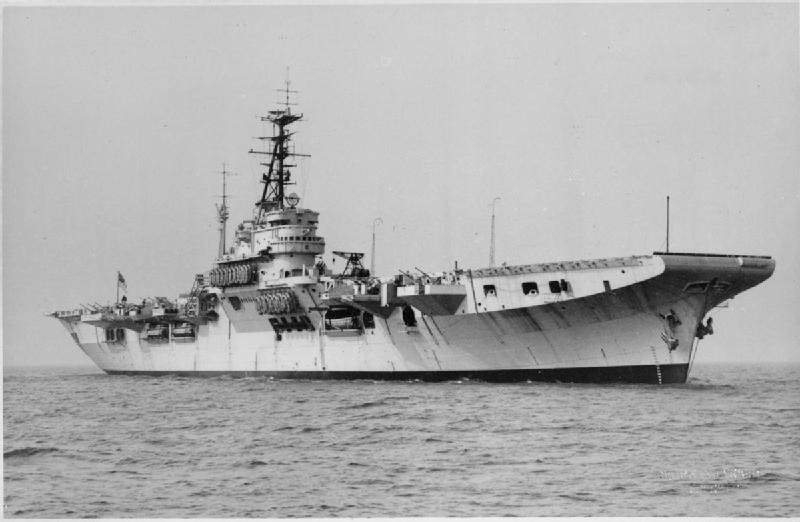
HMS Triumph
HMS Triumph was launched on 2 October 1944 and commissioned on 6 May 1946. After working up and training, doing pilot qualiifications, by February 1947 she was assigned to the 2nd Aircraft Carrier Squadron based in Mediterranean Fleet, until August 1948. Back home she was refitted and placed in reserve, then recommissioned in 1950 for the Korean war.
Korean War service
She was prepared and departed for Japan, assigned to the Far East Fleet based in Sasebo, as tensions grew in the the region. Before going there she learned off Hong Kong as war breoke out in the peninsula so she was placed in state of high alert as her escort, the destroyer Cossack, also in charge of HMS Theseus. All refuelled at the Royal Australian Naval base at Kure in Japan and the destroyer Consort and the cruiser Jamaica joined the fleet as the Australian River-class frigate Shoalhaven and Fleet Auxiliary tanker Wave Conqueror.
The task force sailed for Okinawa to refuel and proceeded to the western Korean coast to join other assests of the Royal Navy. Beng the first, and sole British carrier in the Far East at the time, she was to be given a considerable role. This force joined the US Fleet with the 827 Naval Air Squadron (Triumph’s air group) with Fairey Firefly on board loaded with rockets to commence operations. They were escorted by 800 NAS Seafires.
Thus air group operated with the Corsairs and Bearcats of the USS Valley Forge. They concentrated on airfields at Pyongyang and Haeju (3 July). It happened soon however the resemblance of the Seafire to the North Korean Yak-9 play in a tragic “blue on blue” on 19 July 1950. The pilot was rescued by a Supermarine Sea Otter (replacement for the Walrus).
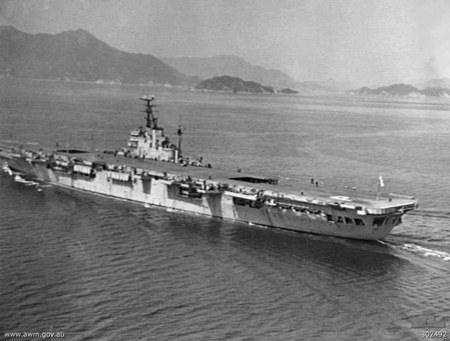
HMS Triumph (R16) off Iwakuni
On 28 July, a flight of Seafires investigated a flight of American B-29 bombers, which mistook them for Yaks and fired, downing one of the Seafires. The pilot was later rescued by USS Eversole due to the weather conditions. Seafires provided mostly CAP and Fireflies ASW patrols when not used for air attacks. Eventually HMS Triumph left for Kure to resplenish and rest for eight days. On 9 July she was back escorted by the cruiser HMS Kenya, destroyer Comus and the Canadian Athabaskan and Sioux. Seafires also started photo-reconnaissance missions over Mokpo, Kunsan, Chinnam and Incheon for the UN forces and later destroyed two North Korean gunboats. They also dealt with railway tracks, coasters and oil tanks.
On 23 August HMS Triumph sufferring the attrition rate of its seafires and firefly only had nine operational aircraft left. She departed for Saseb with USS Valley Forge and Philippine Sea. Meanwhule the North Korean managed to badly damage HMS Comus, sent to Kure for repair escorted by Consort. After this, CAP were doubled down. On 29 August, a Firefly missed, ended in the safety barrier and a piece of propeller blade penetrated the operations room, killing Lt. Cdr. I. M. McLachlan (800 NAS). On 30 August she returned to Sasebo, received 14 new aircraft from HMS Unicorn. On 3 September, HMS Triumph departed Sasebo for the West Coast, and started to perform CAP and reconnaissance, bombardment spotting notably for Jamaica and Charity.
From the 6 September escorted by Athabaskan, Warramunga and Bataan she replaced the US 7th Fleet on the east coast, launching operations from the 8th, but bad weather almost stopped them on the 9th. An airfield at Koryo was devastated still. 800 NAS later was down to six aircraft and the ship proceeded back to Sasebo. She would be soon recalled to take part in the Battle of Inchon.
On 12 September, escorted by Warramunga, Charity, Cockade and Concord, HMS Triumph departed to cover the landings at Incheon as part of CTF 91 (Commonwealth Task Force 91). HMS Ceylon and HMAS Bataan of the Northern Group completed the escort. The Southern Group comprised Athabaskan, Cayuga and Sioux. Triumph provided ASW patrols, interdiction and spotting. Fireflies also made bombardment spotting for Jamaica and Kenya, obliterating North Korean positions and a weapons cache, decapitating a hill and creating a 8,000 feet smoke plume.
Admiral Andrewes and UN commander General Douglas MacArthur congratulated the carrier with “My heartiest felicitations on the splendid conduct of the Fleet units under your command. They have added another glamorous page to the long and brilliant histories of the Navies of the British Commonwealth.”
On 17 September, North Korean aviation maaged to arrive at low altiude not to be radar-picked and damaged the cruisers Rochester and Jamaica, so CAPs doubled down. On 21 September HMS Triumph was bacl to Sasebo for the last time, in dry dock for fixes and sailed to Hong Kong on 25 September, relieved by HMS Theseus.
Later carrer:
Back from Korea, HMS Triumph replaced the old Country-class HMS Devonshire as cadet training ship. She carried 100 RN and Commonwealth cadets on three yearly cruises (West Indies, Scandinavia and British Islands, and Mediterranean). At the time she also had three training Boulton Sea Balliol aboard.
In 1952, she was used for angled flight deck markings trials, which success led to the development of this new design, before further modifications were made. In 1954, she ferried survivors of the troopship Empire Windrush from North Africa to Gibraltar.
In 1955 she made a ‘goodwill’ visit to Leningrad with her new captaibn, Varyl Begg. Cadet training duties ended the same year after the autumn cruise, now redundant. The admirakty decided toconvert her as a repair ship, a new career between 1956 and 1965, an new pennant “A108”. She based in Singapore, taking part in major international exercises in 1968. She was also used to transport troops during the Vietnam war. In 1975, back home, she was placed in reserve at Chatham Dockyard but only struck in 1981, scrapped in Spain, the very last Colossus class in British service.
 HMS Perseus (1944)
HMS Perseus (1944)

HMS Perseus
HMS Perseus (R51) was launched as HMS Edgar on 26 March 1944, but renamed Perseus in July 1944 when it was decided to convert her as an aircraft maintenance ship. She was completed on 19 October 1945 after this redesign.
Conversion as repair and maintenance carrier
To maximize space for workshops and stores, her arresting gear and catapult were not fitted. All facilities for flying operations were removed as well and instead, two large deckhouses were constructed, port of the island and at the rear of the flight deck. Her single hangar was modified to maximize storage and she kept her two aircraft lifts and had two large cranes mounted on the flight deck and two small self-propelled lighters for carrying unflyable aircraft and transfer them between ships or shore. She also carried more bulk petrol storage, 98,600 imperial gallons (448,000 l; 118,400 US gal) total and had a crew of 854 and an additional 222 repair personal.
All repair tests were carried out aboard in the hangar or on deck, and she had workshops for engine repair and component manufacturing tooling of needed, plus large reserves of spares for all types in service.
Early service in the far east
HMS Perseus arrived in Portsmouth on 24 October 1945, started working up until departing for Australia on 17 November, arriving in Sydney on 21 December, taking charge of the “Air Train” supporting the British Pacific Fleet. She later returned to Melbourne and departed on 26 March 1946 with a load of aircraft to return home, arriving at Rosyth on 17 May. She was placed in reserve amidst postwar austerity.
Catapult Test ship (1950-52)
In 1950 she was used to test an experimental steam catapult, placed on top of her existing flight deck, the port deckhouse being removed. This large catapult intended for jest made some 1,560 launches with at first 1,000 wheeled dead-loads of varying weights, up to unmanned aircraft and manned aircraft of all Fleet Air Arm types. She was sent to Philadelphia, USA, on 14 January 1952 to demonstrate it to the Navy staff, launching 127 manned aircraft, including of USN models of various types. After this, HMS Perseus was back in Portsmouth on 21 March, her catapult removed as her maintenance equipment. She was converted now as a ferry carrier.
Ferry carrier (1953-57)
On 10 December 1952 she carried her first load of Westland Whirlwinds helicipters (848 Sqn) to Singapore, arriving on 8 January 1953 and back to Portsmouth on 11 February. Then she carried a part of embarked part of the 100 Grumman Avengers transferred until the Mutual Defense Assistance Act back in the US, Norfolk, on 16 March. She loaded the remaining one on 29 April. HMS Perseus back home was refitted to carry VIPs, with a temporary grandstand seatin by June. She hosted the press during Elizabeth II’s Coronation Fleet Review in Spithead. She also carried later in 1953 troops and equipment to the Far East.
On 20 January 1954, ASW trials by the Whirlwind helicopter were made, and successful. Redesignated the 845 Squadron it was ferried to Malta in April 1954. Back home, Perseur made another supply run to Singapore this time, for the remaining combat in Korea. Back home she went into reserve from 12 July. It was planned to convert her as a submarine depot ship and she was sent to Belfast for the conversion by 1955, but it was delayed and in 1957 the Defence White Paper had it abruplty cancelled. Instead she was towed to Gare Loch and stayed there until sold for BY by May 1958, towed to Port Glasgow for scrapping.


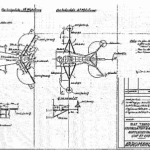

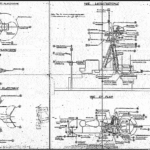
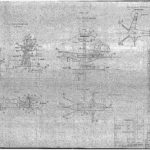
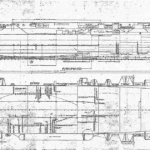
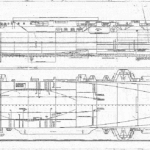
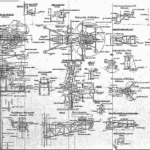
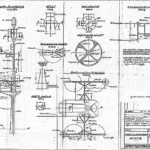

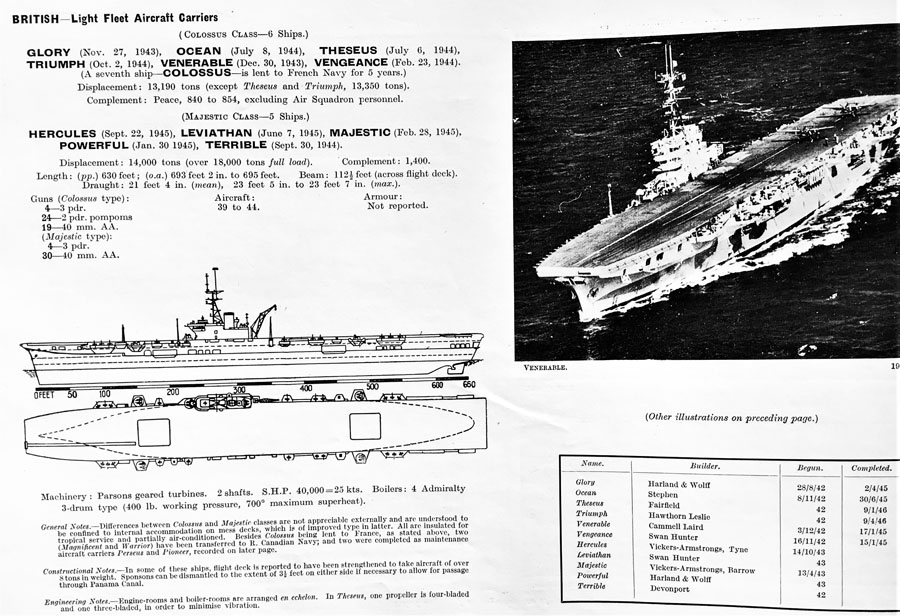
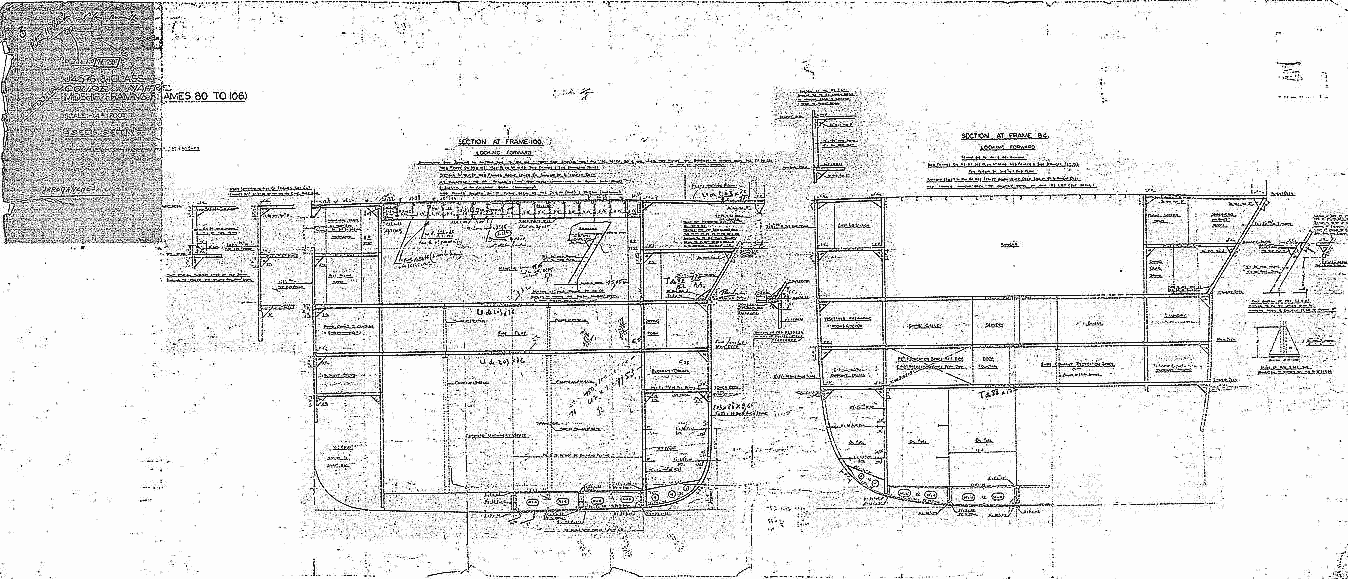
 Latest Facebook Entry -
Latest Facebook Entry -  X(Tweeter) Naval Encyclopedia's deck archive
X(Tweeter) Naval Encyclopedia's deck archive Instagram (@navalencyc)
Instagram (@navalencyc)





 French Navy
French Navy Royal Navy
Royal Navy Russian Navy
Russian Navy Armada Espanola
Armada Espanola Austrian Navy
Austrian Navy K.u.K. Kriegsmarine
K.u.K. Kriegsmarine Dansk Marine
Dansk Marine Nautiko Hellenon
Nautiko Hellenon Koninklije Marine 1870
Koninklije Marine 1870 Marinha do Brasil
Marinha do Brasil Osmanlı Donanması
Osmanlı Donanması Marina Do Peru
Marina Do Peru Marinha do Portugal
Marinha do Portugal Regia Marina 1870
Regia Marina 1870 Nihhon Kaigun 1870
Nihhon Kaigun 1870 Preußische Marine 1870
Preußische Marine 1870 Russkiy Flot 1870
Russkiy Flot 1870 Svenska marinen
Svenska marinen Søværnet
Søværnet Union Navy
Union Navy Confederate Navy
Confederate Navy Armada de Argentina
Armada de Argentina Imperial Chinese Navy
Imperial Chinese Navy Marinha do Portugal
Marinha do Portugal Mexico
Mexico Kaiserliche Marine
Kaiserliche Marine 1898 US Navy
1898 US Navy Sovietskiy Flot
Sovietskiy Flot Royal Canadian Navy
Royal Canadian Navy Royal Australian Navy
Royal Australian Navy RNZN Fleet
RNZN Fleet Chinese Navy 1937
Chinese Navy 1937 Kriegsmarine
Kriegsmarine Chilean Navy
Chilean Navy Danish Navy
Danish Navy Finnish Navy
Finnish Navy Hellenic Navy
Hellenic Navy Polish Navy
Polish Navy Romanian Navy
Romanian Navy Turkish Navy
Turkish Navy Royal Yugoslav Navy
Royal Yugoslav Navy Royal Thai Navy
Royal Thai Navy Minor Navies
Minor Navies Albania
Albania Austria
Austria Belgium
Belgium Columbia
Columbia Costa Rica
Costa Rica Cuba
Cuba Czechoslovakia
Czechoslovakia Dominican Republic
Dominican Republic Haiti
Haiti Hungary
Hungary Honduras
Honduras Estonia
Estonia Iceland
Iceland Eire
Eire Equador
Equador Iran
Iran Iraq
Iraq Latvia
Latvia Liberia
Liberia Lithuania
Lithuania Mandchukuo
Mandchukuo Morocco
Morocco Nicaragua
Nicaragua Persia
Persia San Salvador
San Salvador Sarawak
Sarawak Uruguay
Uruguay Venezuela
Venezuela Zanzibar
Zanzibar Warsaw Pact Navies
Warsaw Pact Navies Bulgaria
Bulgaria Hungary
Hungary

 Bundesmarine
Bundesmarine Dutch Navy
Dutch Navy Hellenic Navy
Hellenic Navy Marina Militare
Marina Militare Yugoslav Navy
Yugoslav Navy Chinese Navy
Chinese Navy Indian Navy
Indian Navy Indonesian Navy
Indonesian Navy JMSDF
JMSDF North Korean Navy
North Korean Navy Pakistani Navy
Pakistani Navy Philippines Navy
Philippines Navy ROKN
ROKN Rep. of Singapore Navy
Rep. of Singapore Navy Taiwanese Navy
Taiwanese Navy IDF Navy
IDF Navy Saudi Navy
Saudi Navy Royal New Zealand Navy
Royal New Zealand Navy Egyptian Navy
Egyptian Navy South African Navy
South African Navy






























 Ukrainian Navy
Ukrainian Navy dbodesign
dbodesign